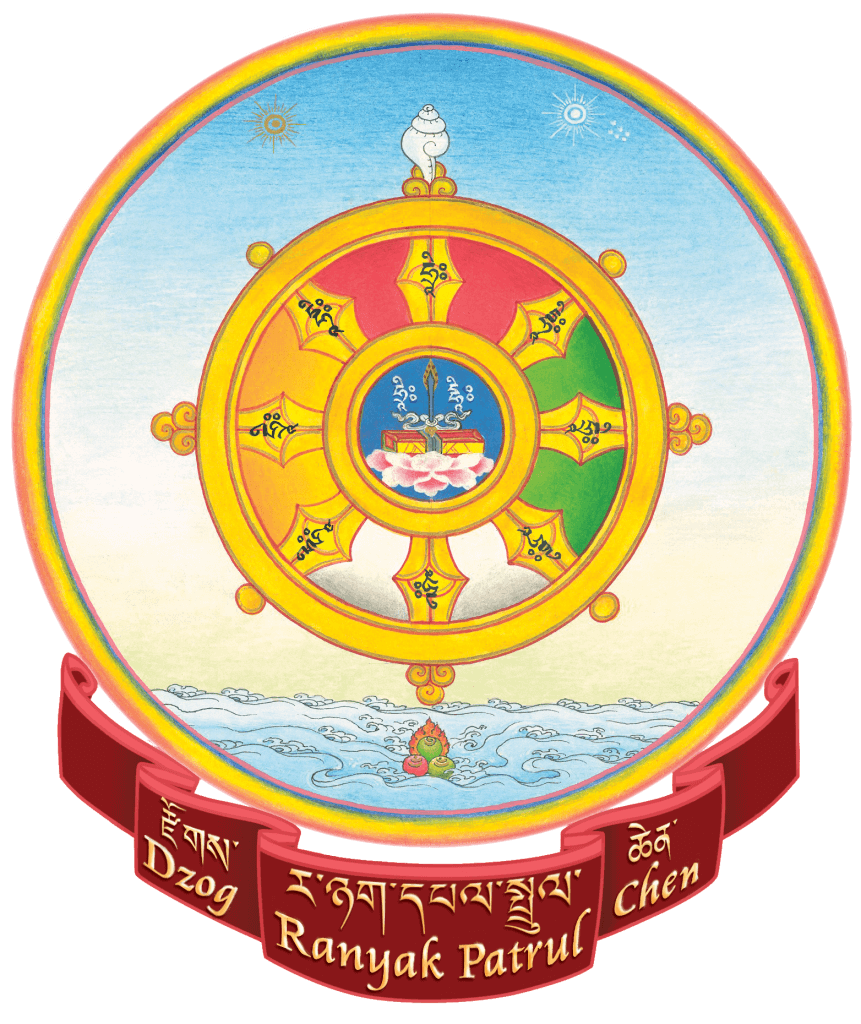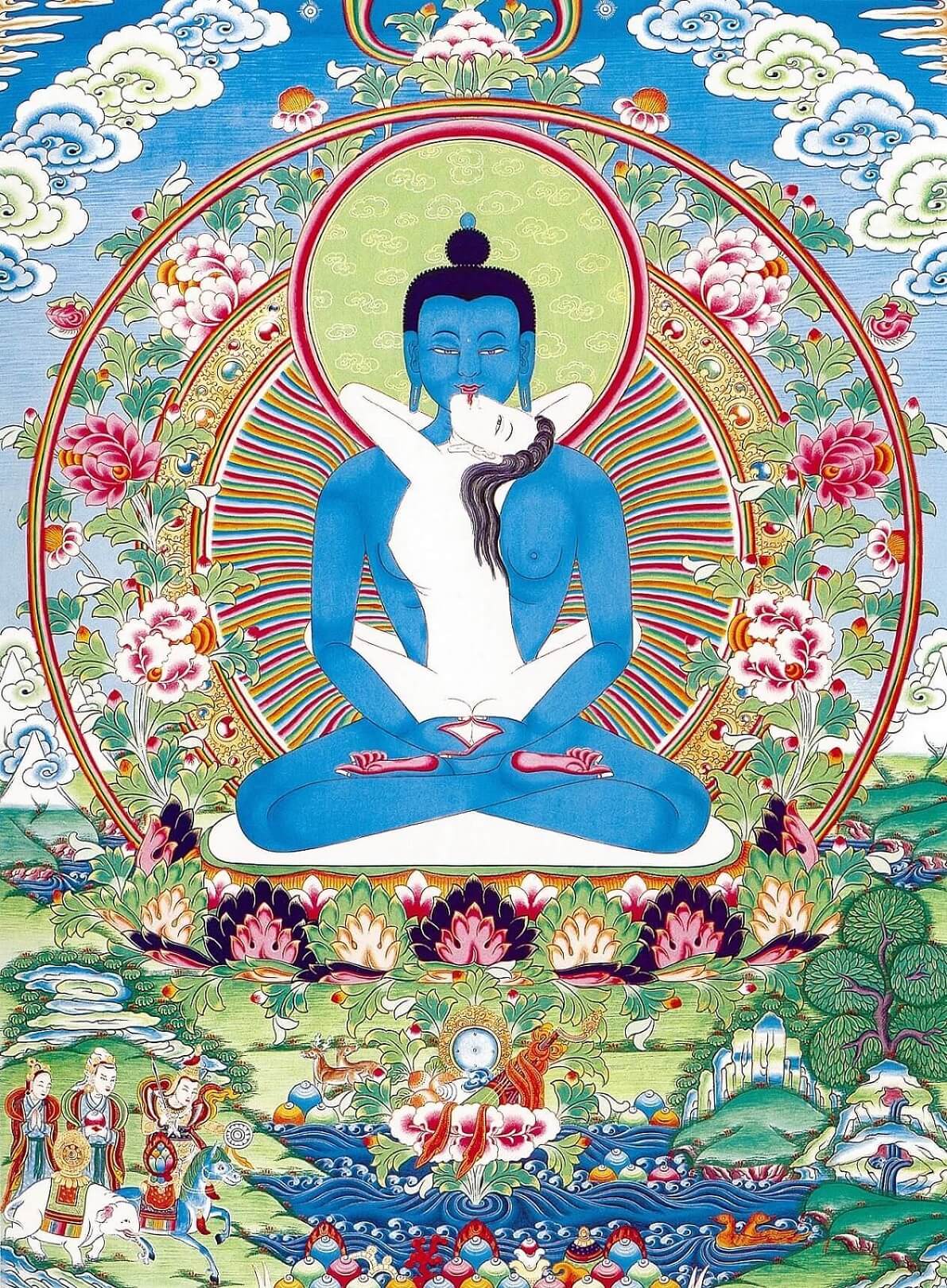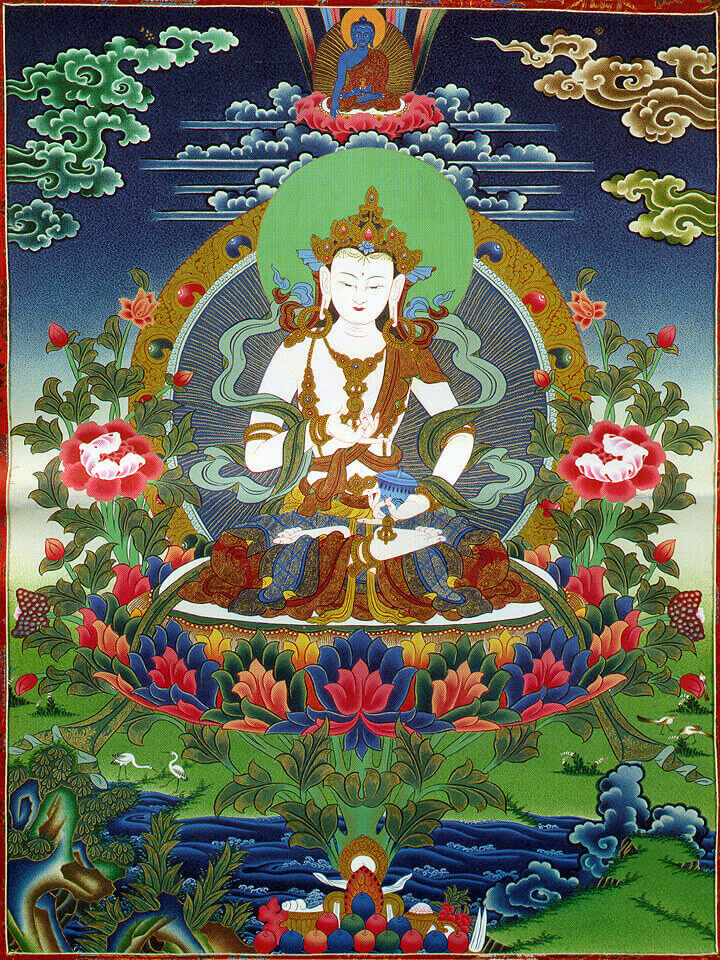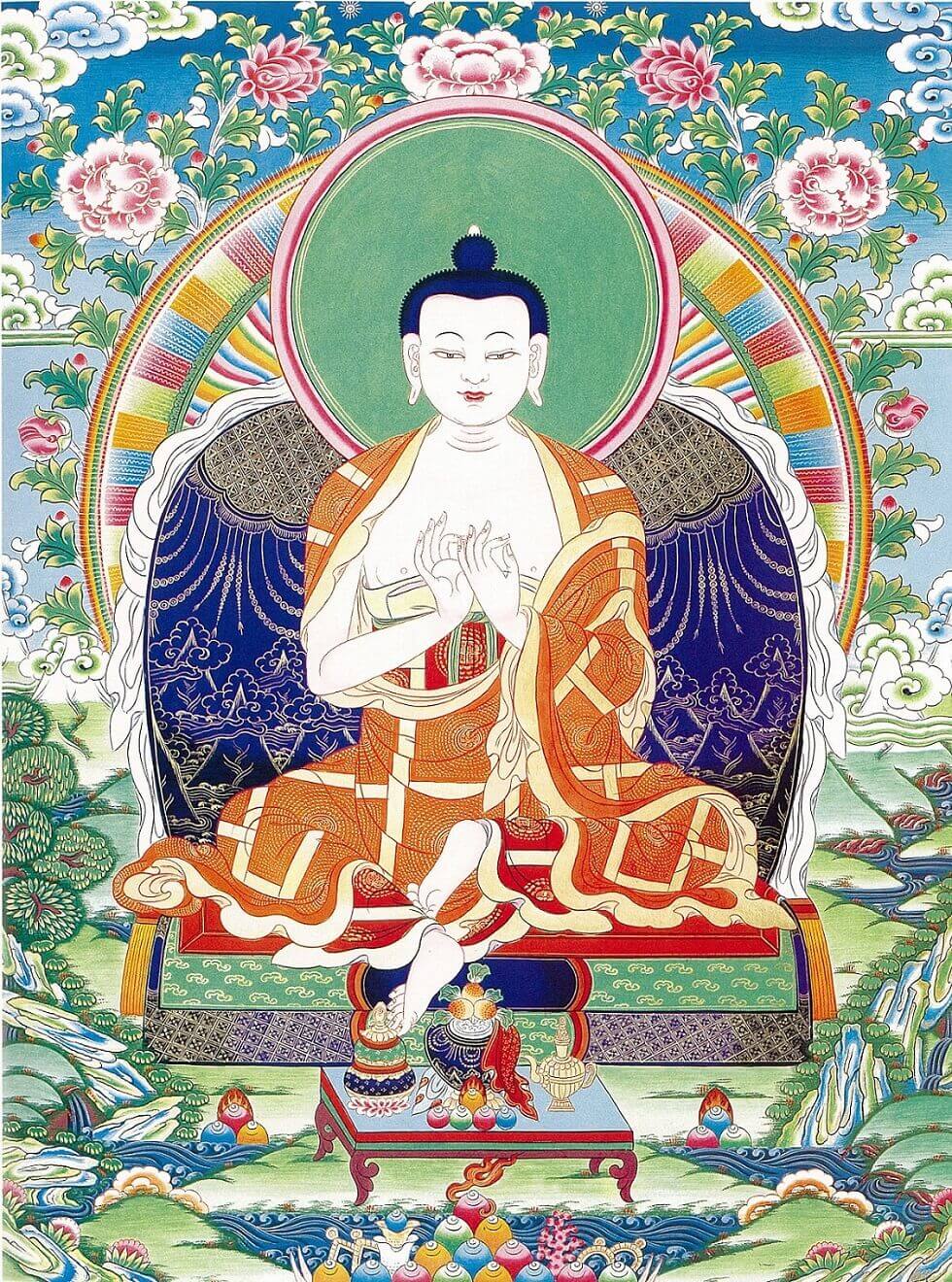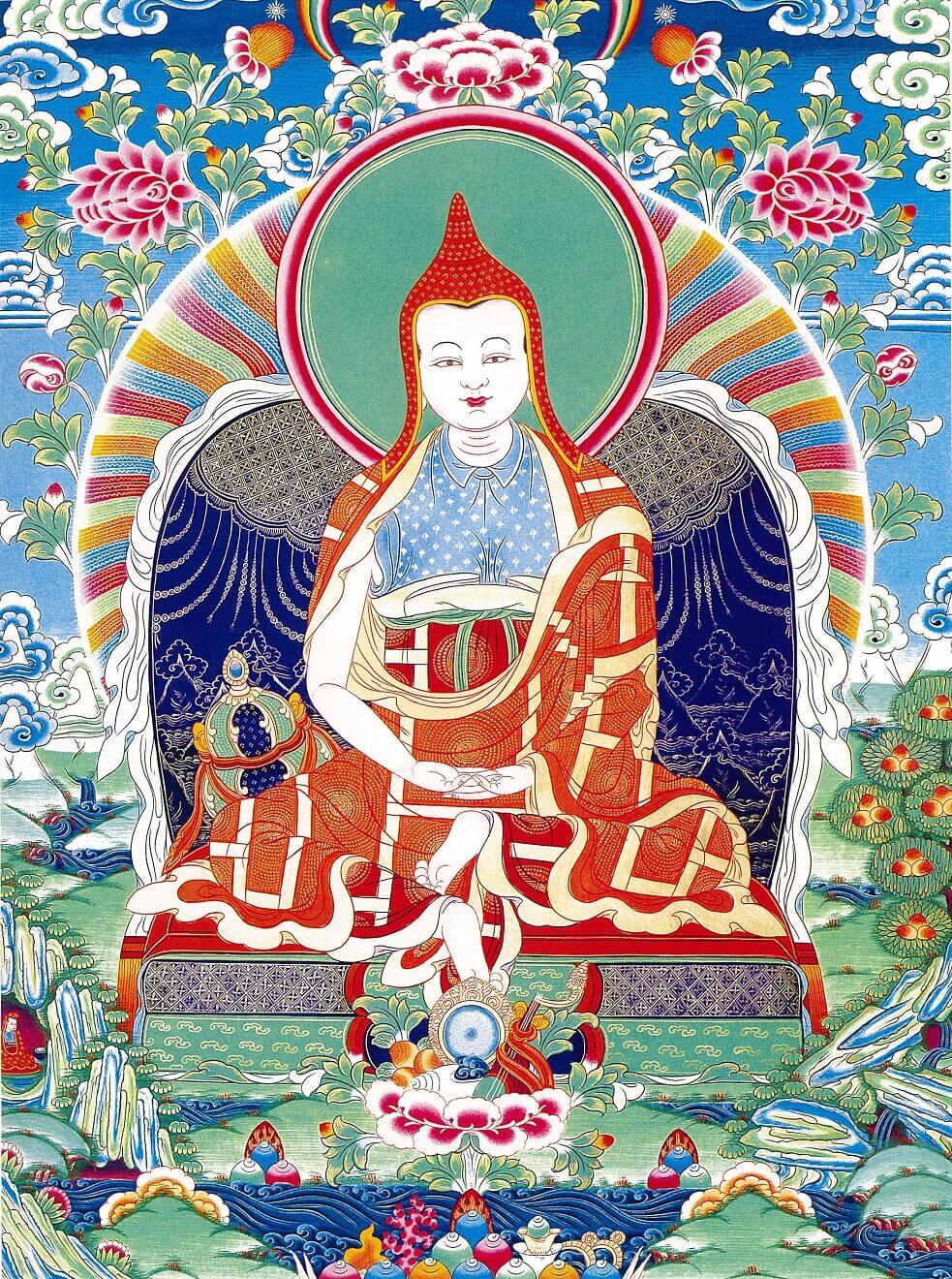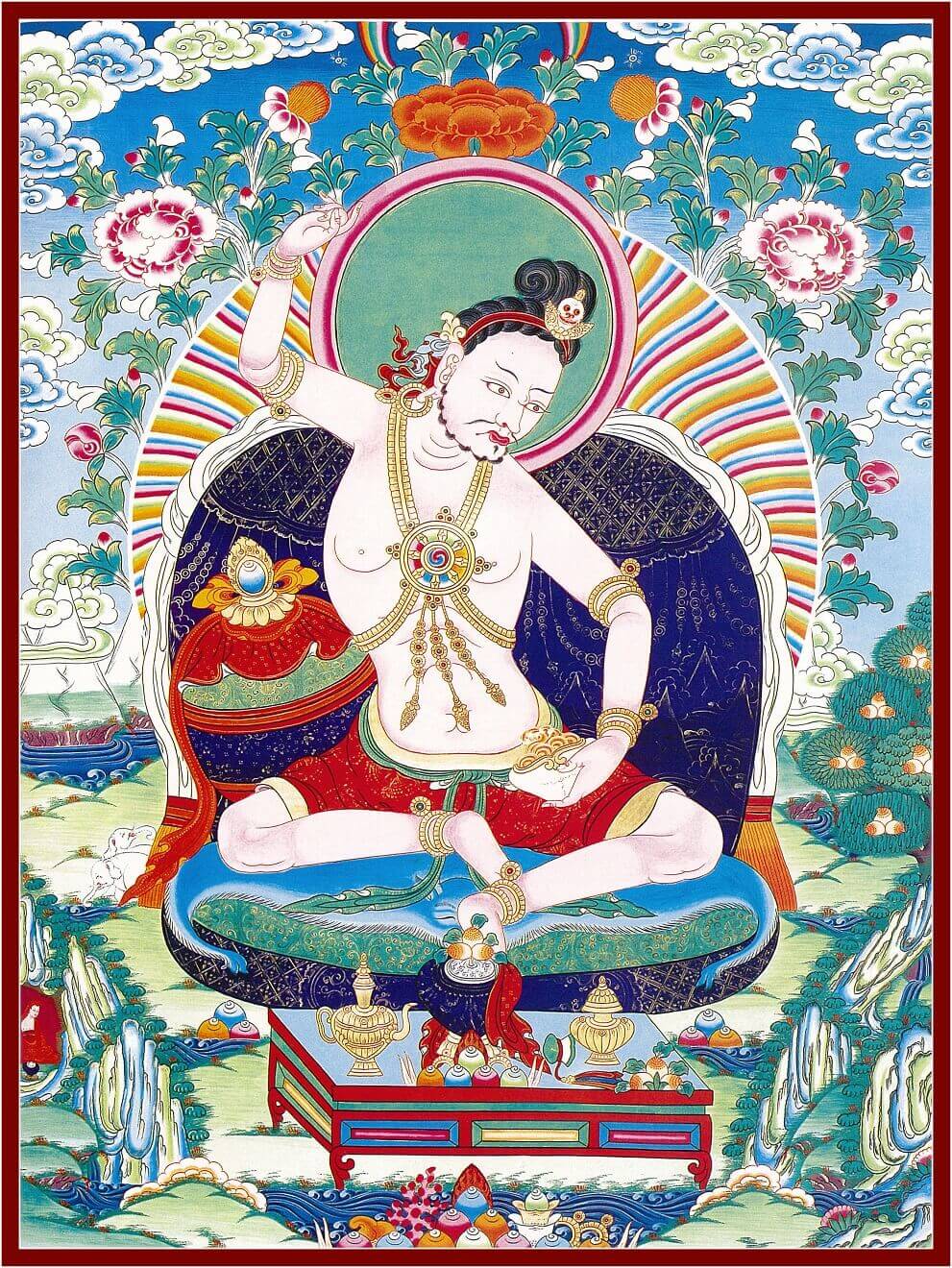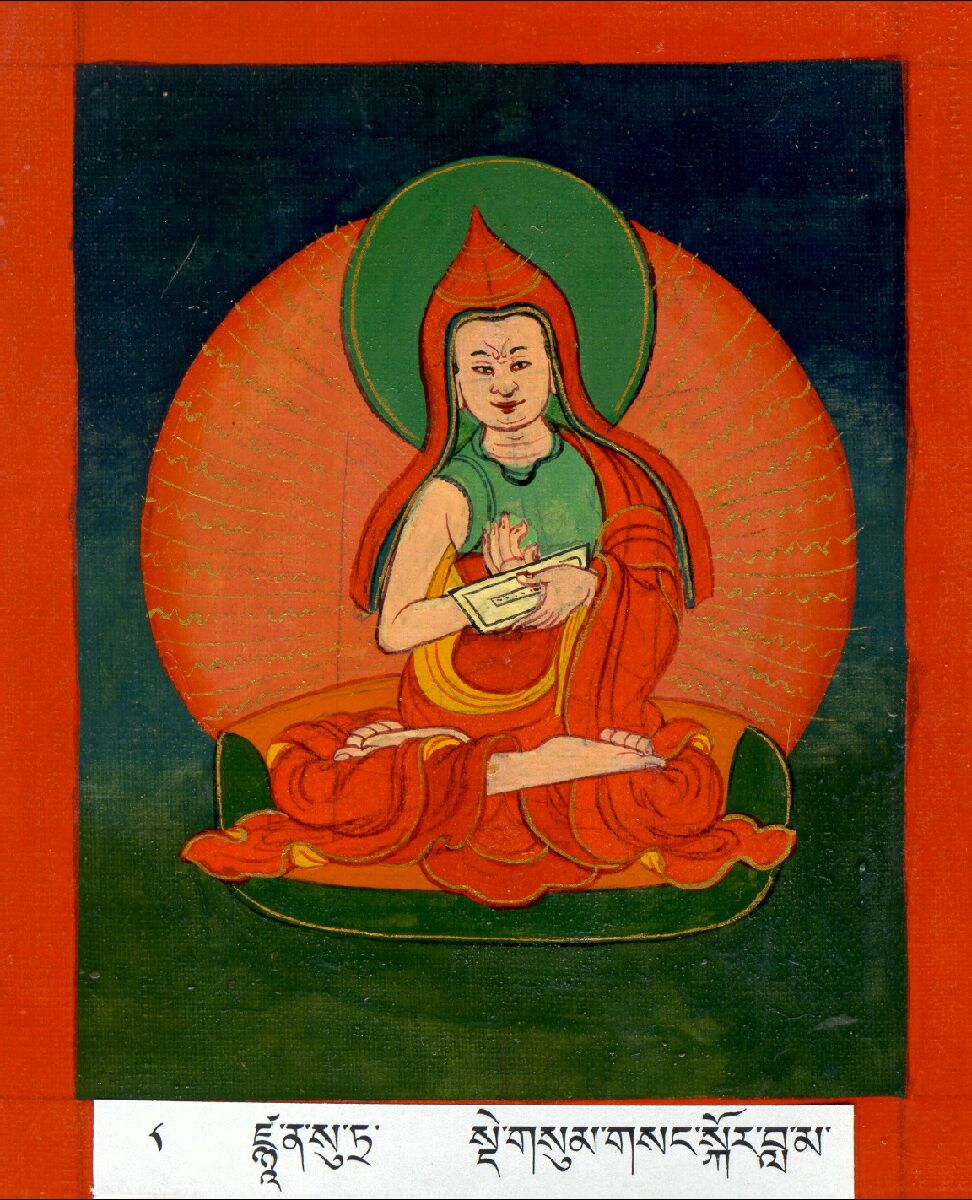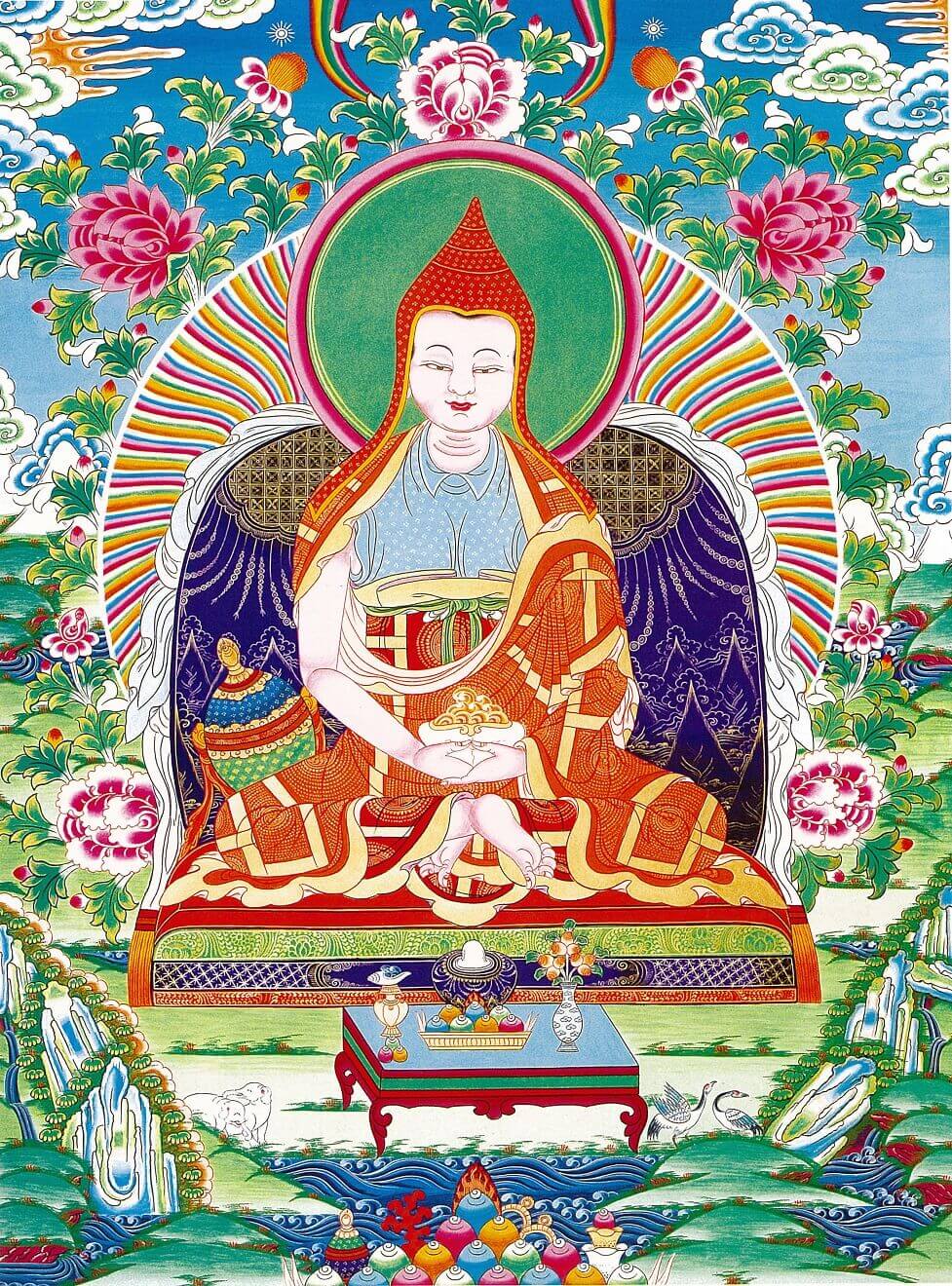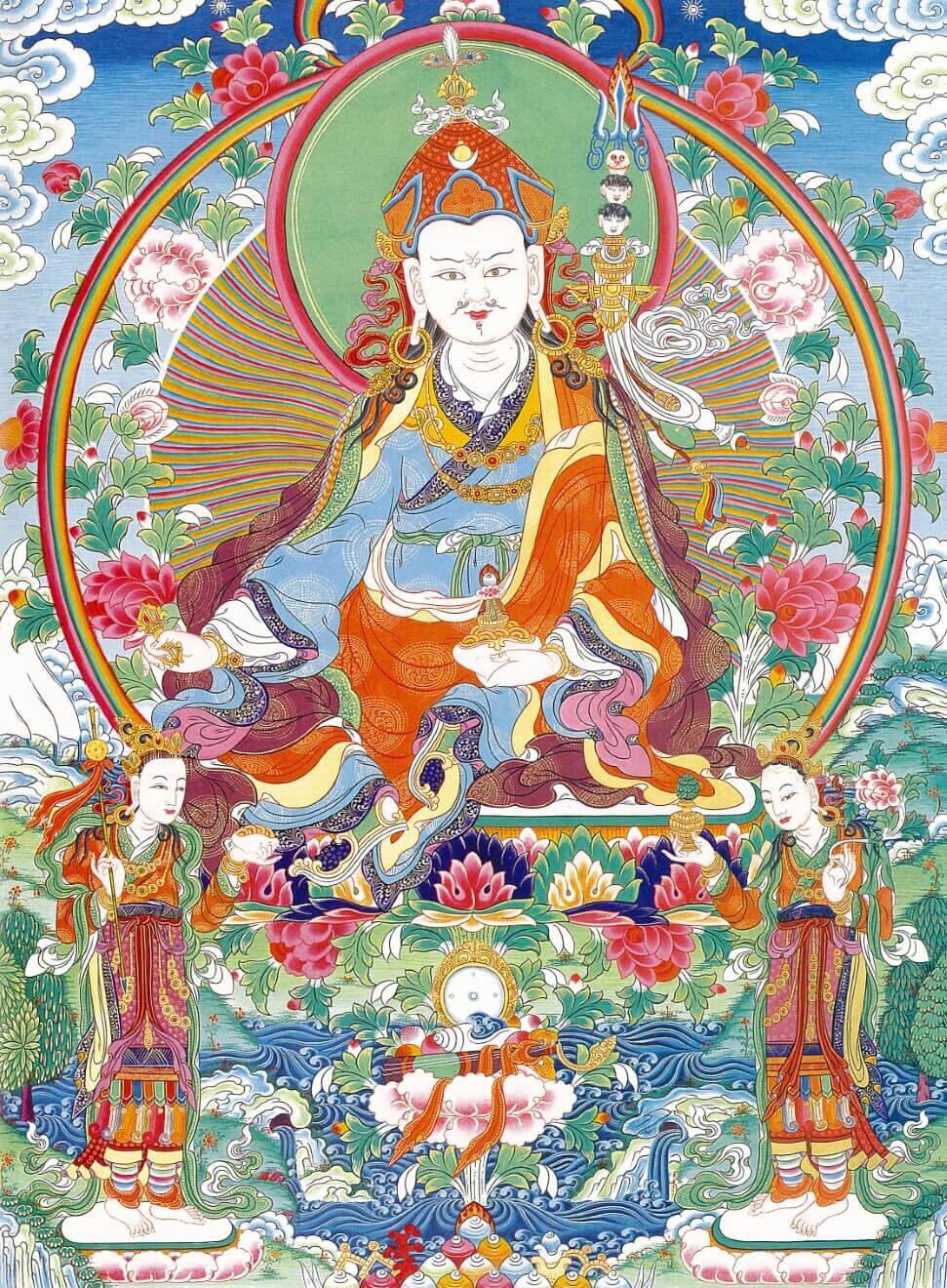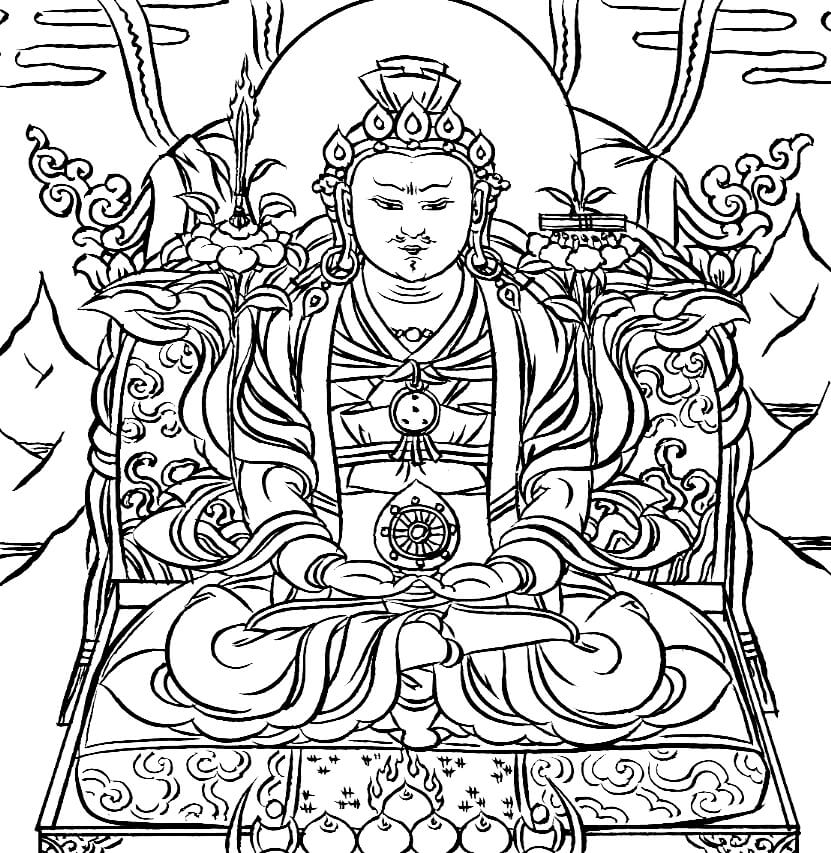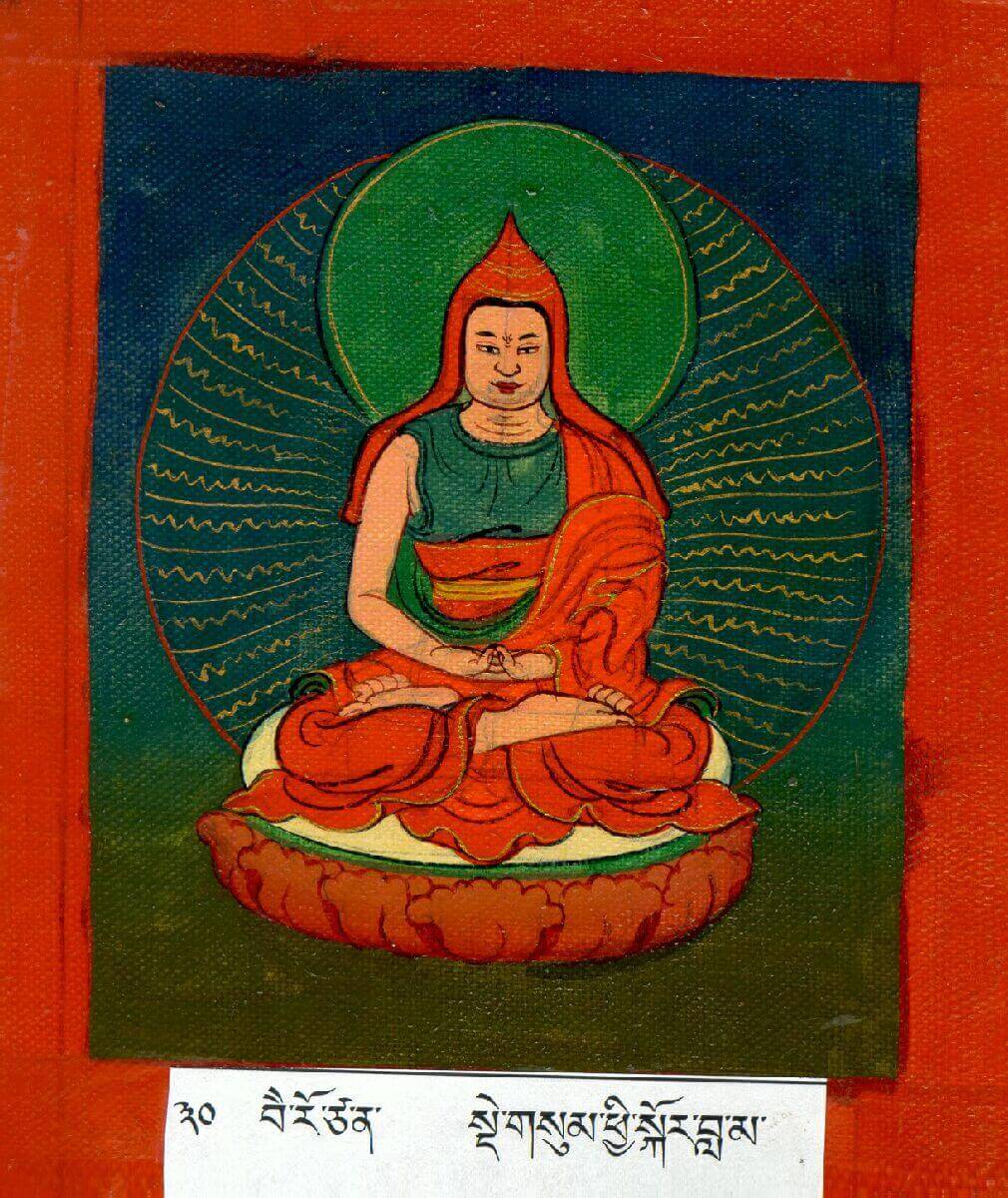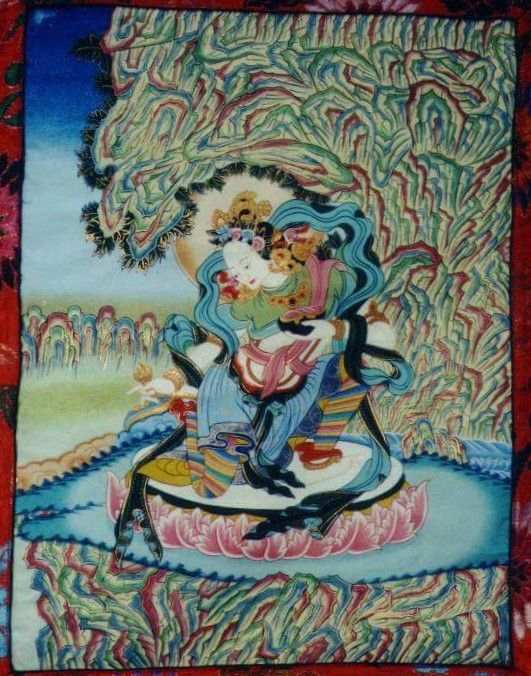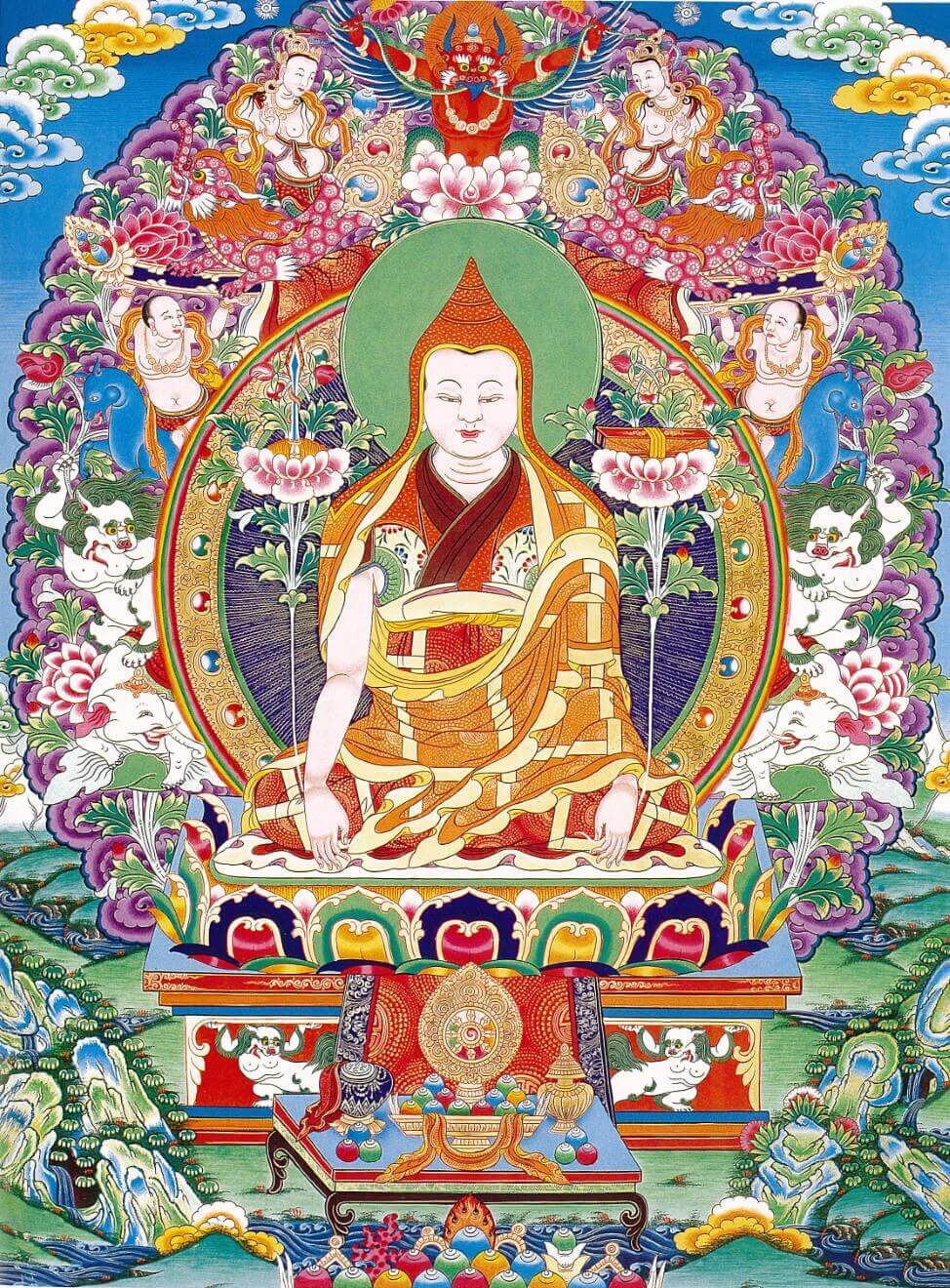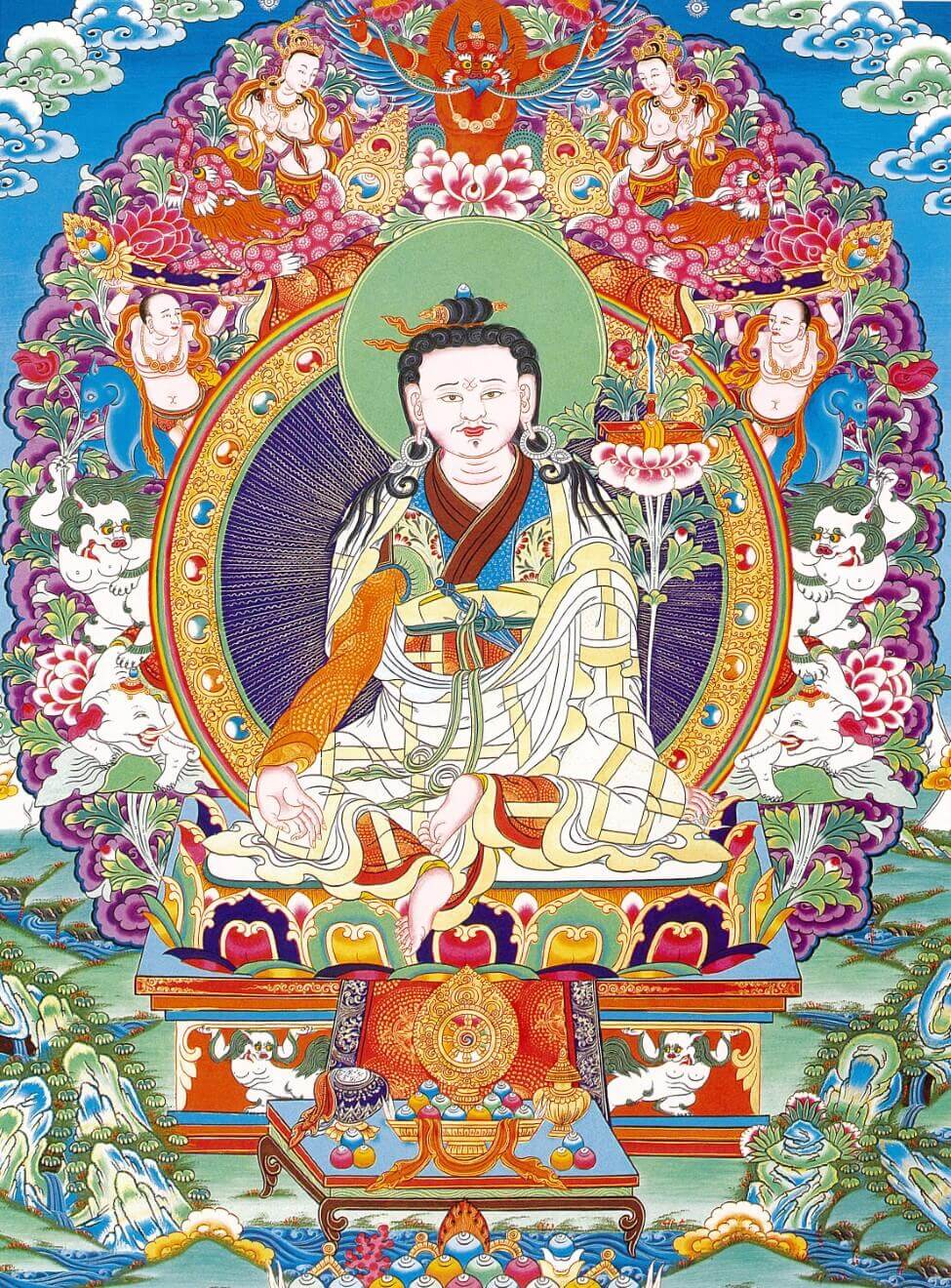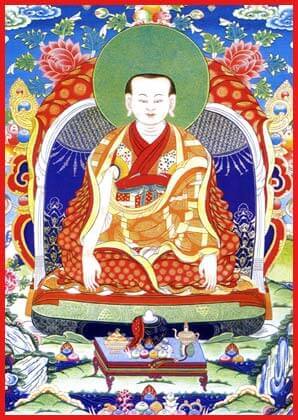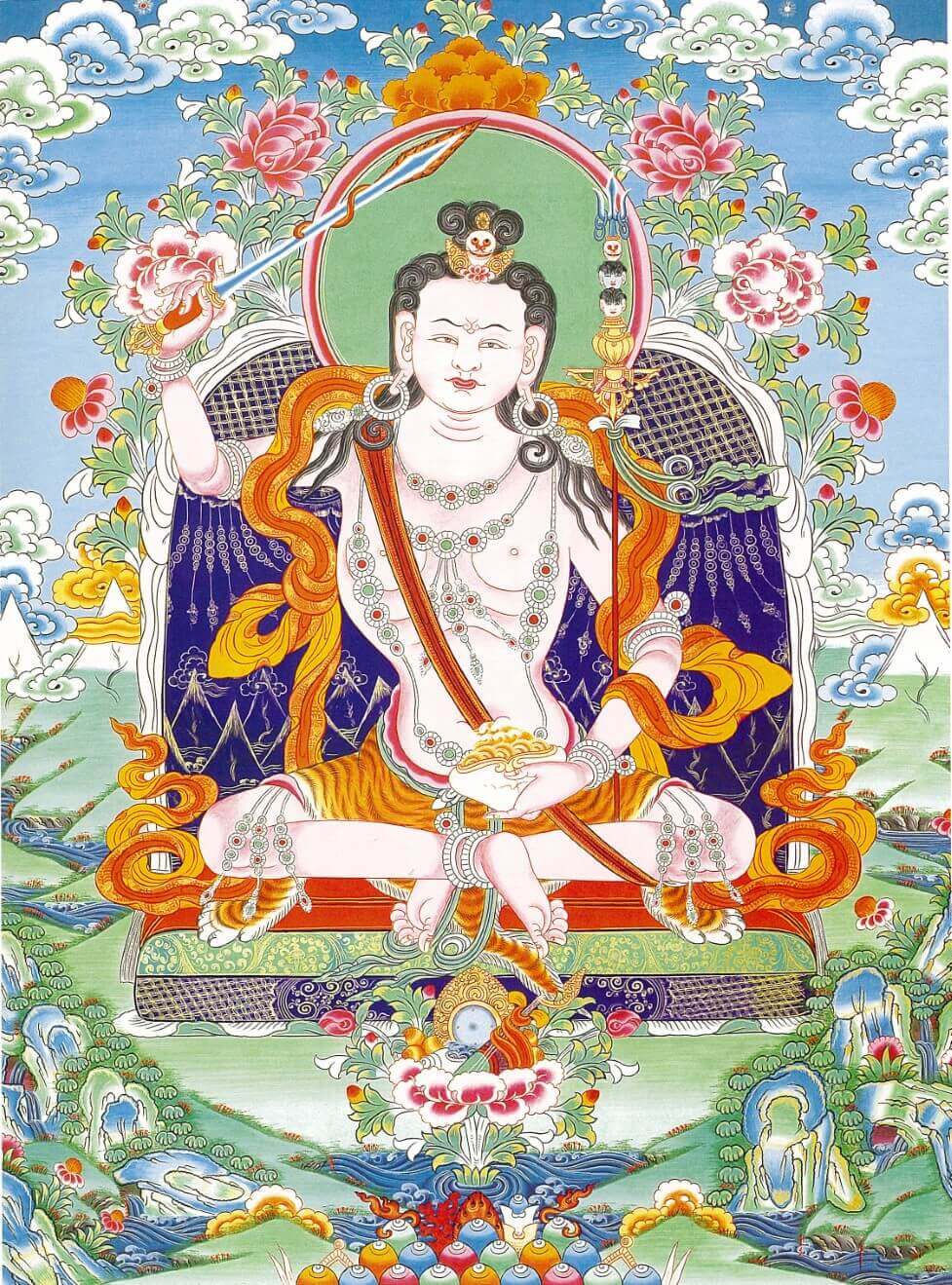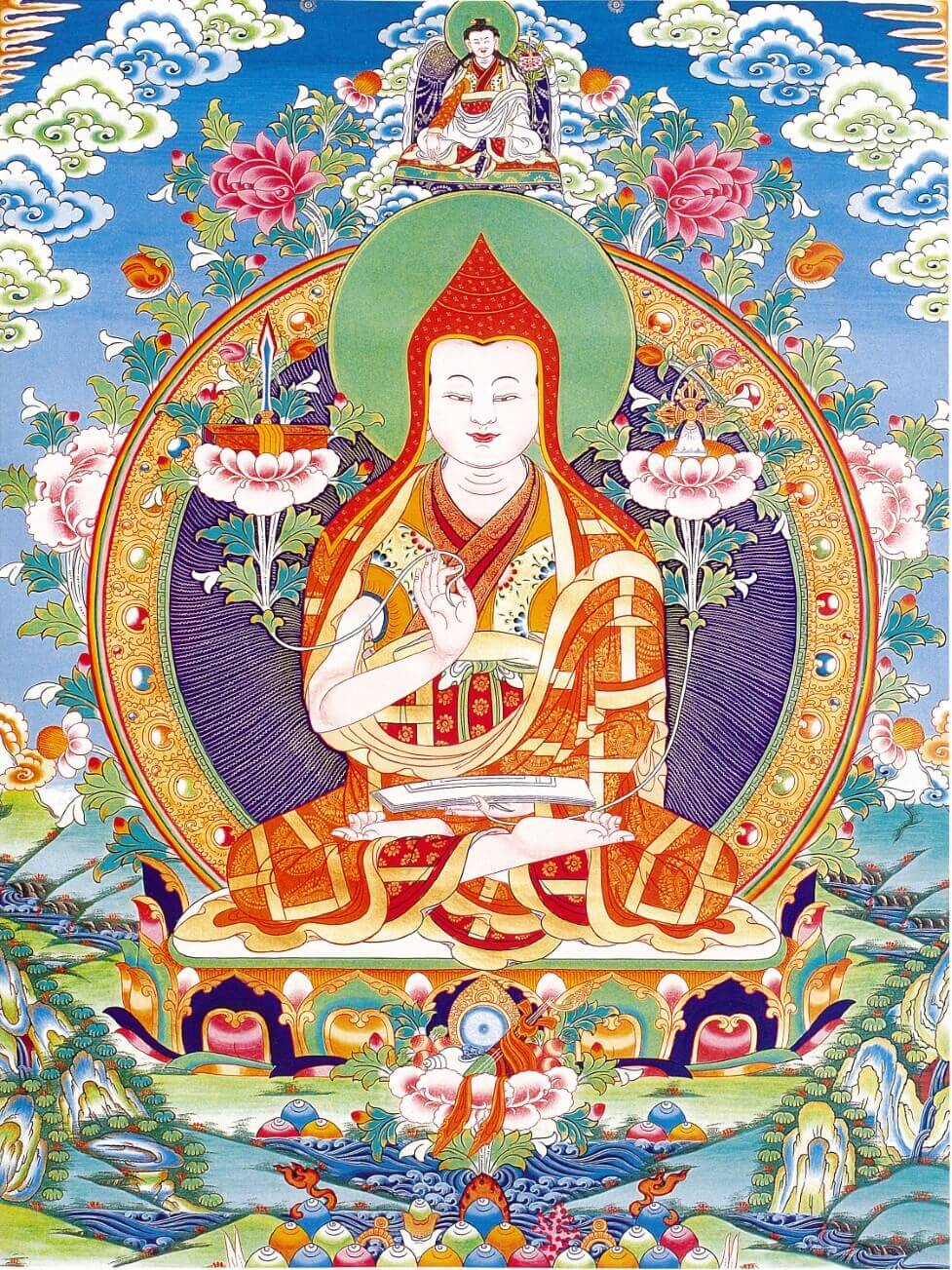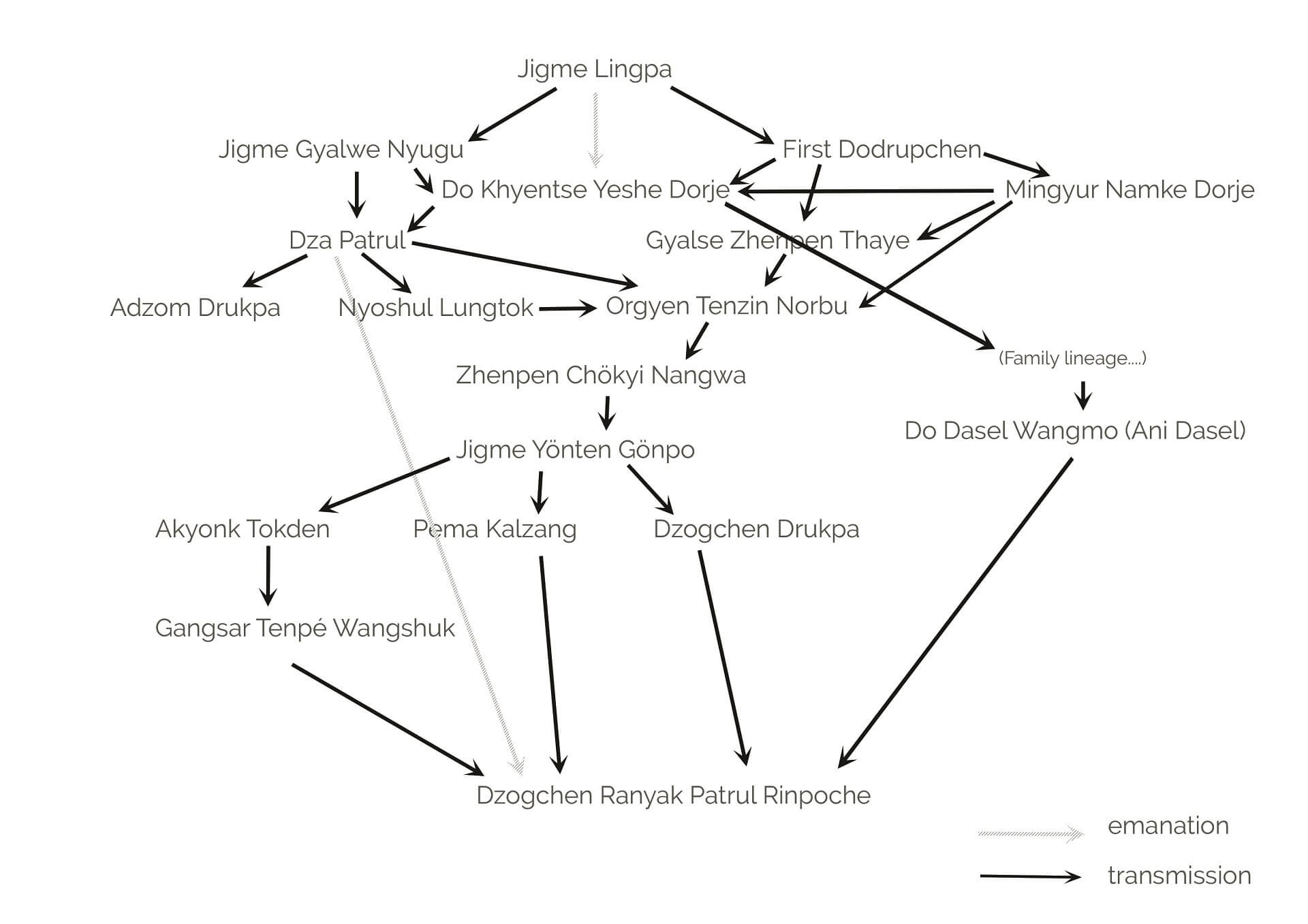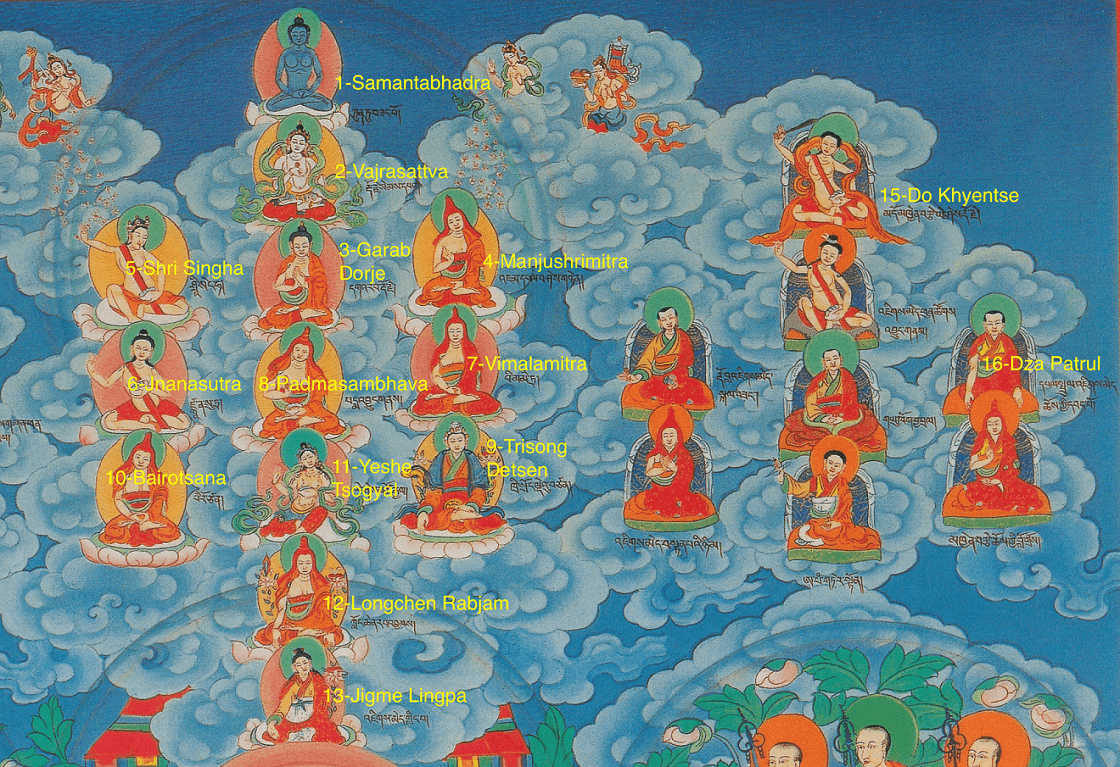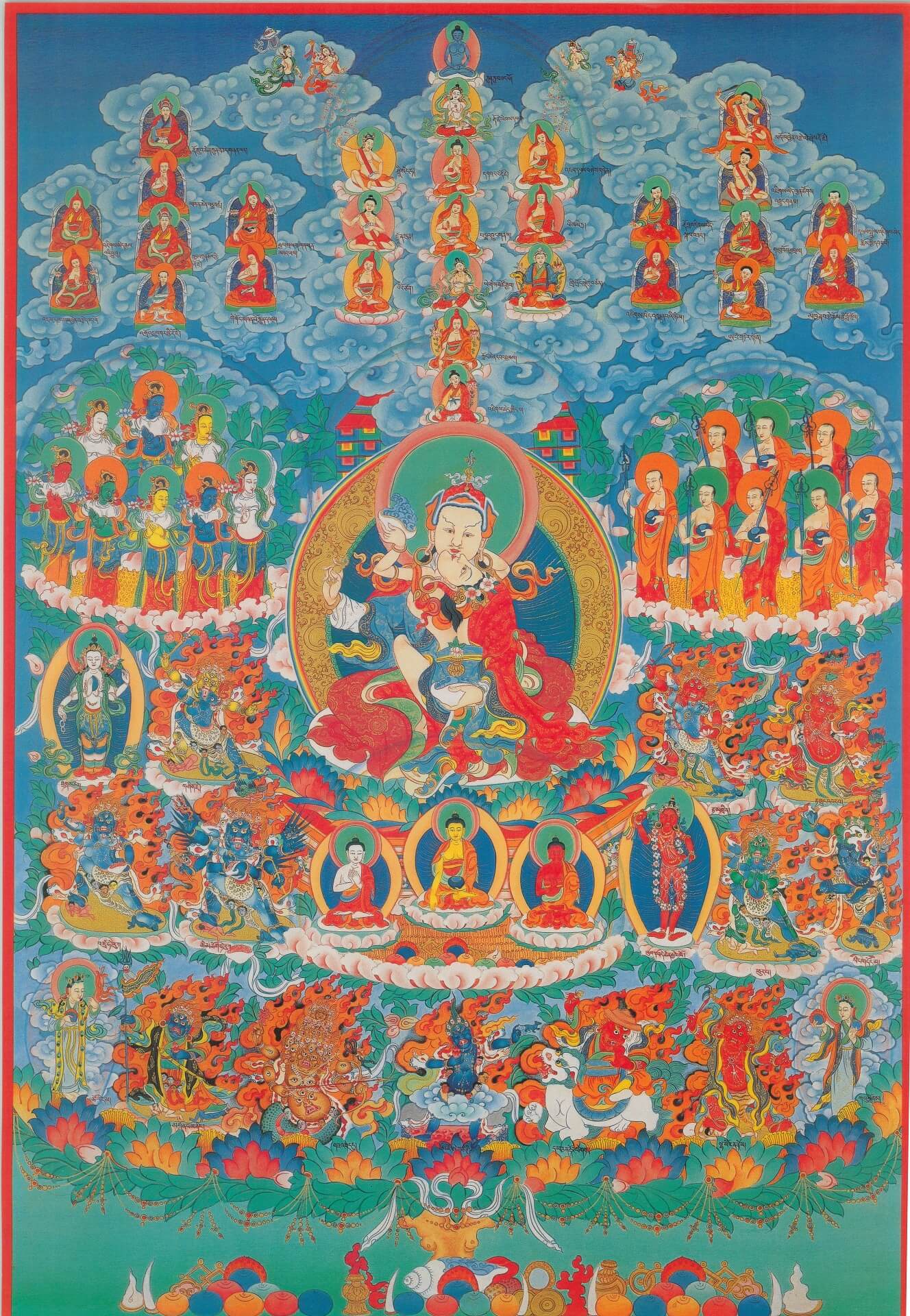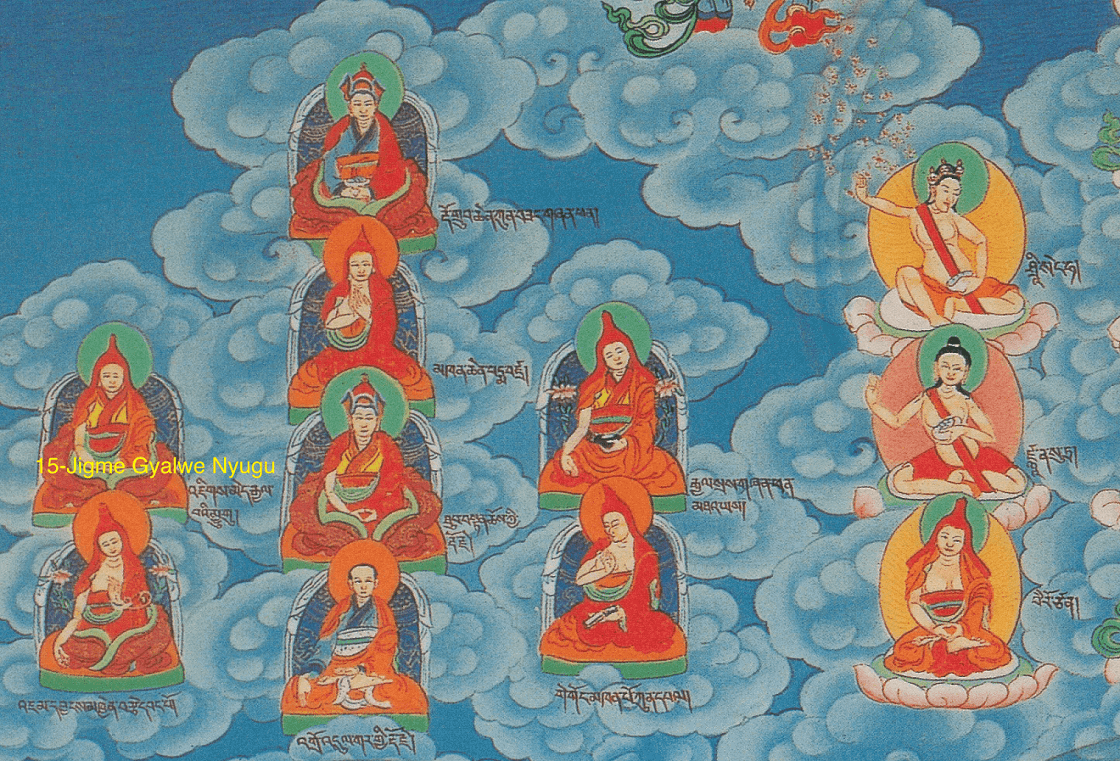The Longchen
Nyingthik
Co to jest linia przekazu?
Jest to linia dziedzictwa zrealizowanych mistrzów, którzy otrzymali i opanowali określony cykl nauk. Zaczyna się ona od ich źródła: Buddy, który je wygłosił. Budda Siakjamuni (Siddhartha Gautama) historyczny Budda naszej ery, który nauczał w Indiach około 2500 lat temu. He imparted teachings in many different ways depending on the dispositions and capacities of his disciples. They, in turn, brought them down to this time in an uninterrupted transmission line, popularizing the path that he had shown. In addition to Buddha Shakyamuni, many beings attained buddhahood in this age. Moreover, there are countless Buddhist teachings that are not written records of words uttered by Buddha Shakyamuni, but that came from various enlightened bodies (kayas). They were transmitted to and practiced by accomplished followers of the Buddhist path introduced by Shakyamuni.
Generally speaking, there are three lineage types: the long lineage of instructions (ka’ma), the short lineage of concealed treasures (terma) and the lineage of the profound pure vision.
What is our lineage?
Our lineage is the Longchen Nyingthik (Heart Essence of the Great Expanse), within the Nyingma School of Tibetan Buddhism. In this tradition the teachings are classified into nine vehicles that require increasing skills to be practiced: three common vehicles of sutras, three uncommon vehicles of outer tantras, and three uncommon vehicles of inner tantras.
As Ranyak Patrul Rinpoche says:
“The lineage lamas of the Longchen Nyingthik, that is, the teachers of the general tantra transmission, are innumerable. Particularly in the Longchen Nyingthik, but not only. All tantras are classified into the three outer tantras—Kriya, Upa, Yoga—and the three inner tantras—Maha, Anu, Ati. Here, we can also speak of another general classification of tantras into four: Kriya, Upa, Yoga and Maha. All schools speak of the four general tantras and the transmission of these lineages. There are numerous lamas of the lineages. But here we keep in mind particularly the figures of the lineage of the Heart Essence of the Great Perfection. The Great Perfection belongs, of course, to the three inner tantras. More specifically, the Great Perfection is the pinnacle vehicle of the tantras and commonly called tantra of the Atiyoga. Why do we call it the Heart Essence? It is like the blood from the heart, the heart core of the great teachings. And thus, it is a heart essence.”
A little more about the Nyingthik…
Several Nyingthik (Heart Essence) transmission lines came from India. As Ranyak Patrul Rinpoche says:
“Of course, there are many Nyingthiks (Heart Essence): The Heart Essence lineage of Vimalamitra (Vima Nyingthik), the Heart Essence of the Lotus (Pema Nyingthik) or Heart Essence of the dakinis (Khandro Nyingthik). And also, there are many other transmissions called ‘Heart Essence’. Here we call it ‘Longchen Nyingthik’, it comes from the Great Perfection and it is the Longchen Nyingthik Heart Essence. ‘Longchen’ means that it comes from the great master Longchenpa. Initially, the Great Perfection comes from the Buddha, of course. But the Buddha did not spread it much in this world, he just gave some prophecy, some forecast saying: “After I die, after I pass away, there will be more teachers who will come.” He pointed out Guru Rinpoche (Padmasambhava), Garab Dorje and so on.”
‘Terma’ treasures, short lineage
The most advanced and profound teachings of the inner tantras were transmitted and flourished in Tibet, including the highest teachings of Dzogchen, the Great Perfection. During the first spread of Buddhism in the 8th century A.D., the second Buddha Padmasambhava took great care of the transmission of the Dharma. He entrusted the teachings to Khandro Yeshe Tsogyal and requested her to hide them, in order to ensure that the highest teachings were revealed at a suitable time, to a suitable audience, without diminishing the blessings. The teachings were concealed in different places, including the minds of the disciples. These teachings are called ‘termas’ (treasures). The later reincarnation of Padmasambhava’s disciples who revealed the teachings are called ‘tertöns’ (treasure revealers). In that way, Padmasambhava avoided the loss and distortions that can occur through a long lineage transmission: it shortened the lineage and the teachings remained intact. Longchen Rabjam revealed the mind terma of the Khandro Nyingthik (a.k.a. Padma Nyingthik—the Nyingthik from Padmasambhava) and was also a holder of the long lineage coming from several generations of lamas back to Vimalamitra, who was in Tibet at the same time as Padmasambhava. Longchen Rabjam united the short lineage of terma and the long lineage of Ka’ma into one: the Longchen Nyingthik.
Dzogchen Ranyak Patrul Rinpoche is an emanation of Dza Patrul Jigme Chokyi Wangpo (1808-1887) and has a profound connection to the Longchen Nyingthik Lineage: Dza Patrul Rinpoche was the direct disciple of Gyalwe Nyugu, the principal student of Jigme Lingpa, who was the spiritual heir of Longchenpa.
The full transmission of the Nyingthik
Long lineage & short Lineage
The Heart Essence flourished in Tibet in two ways: the Vima Nyingthik lineage from the great master Vimalamitra, and the Khandro Nyingthik (or Padma Nyingthik) lineage from the great master Padmasambhava, which both remain uninterrupted until today. Most of the pure profound Dharma lineage holders obtained the rainbow body, which is the dissolution of the aggregates into a body of light.
CONCERNING THE VIMA NYINGTHIK, the glorious Vajrasattva bestowed the great empowerment of the royal vase to the great master Garab Dorje (Prahevajra) who became empowered as the owner of all pith instructions. Having compiled all the 6,400,000 Dzogchen tantras, Garab Dorje taught Manjushrimitra (Jampel Shenyen) using symbolic means. The master Manjushrimitra divided the tantra section of Dzogchen into three—the outer mind section (sems sde), the inner space section (klong sde) and the secret pith instructions section (man ngag sde)—and taught them to the Vidyadhara Shri Singha. Having divided them into four classes—outer, inner, secret and unexcelled innermost secret—, the vidyadhara Shri Singha offered them to Jnanasutra. Shri Singha also transmitted the oral instructions on the outer, inner and secret classes to Vimalamitra, who later received the transmission of the innermost secret class from Jnanasutra, along with the empowerments and the texts. Since Vimalamitra spread them in Tibet, they became known as the Vima Nyingthik.
In general, the Vima Nyingthik is the ka’ma (the oral teachings) and the Khandro Nyingthik is the terma (the treasure teachings).
CONCERNING THE KHANDRO NYINGTHIK, the vidyadhara Shri Singha offered the [Nyingthik] teachings to the great master Padmasambhava. In the 8th century, the great master Padmasambhava’s mind united with both the ka’ma and the terma, and thereby he obtained the life-mastery vidyadhara body and departed to the vidyadhara level of spontaneous presence. Having attained the body of the great transference primordial awareness, he reflected on 1) not letting the sacred Dharma vanish, 2) not mixing up oral instructions, 3) not diminishing the blessings, and 4) shortening long lineages. This reflection is what led to the hidden treasures (terma).
As Ranyak Patrul Rinpoche explains: “After the learned Jnanasutra and the great pandita Vimalamitra came to Tibet, Padmasambhava (Guru Rinpoche) also received the Nyingthik from Garab Dorje himself. Of course, Vimalamitra was also in Tibet at the same time. His three close disciples the Dharma King Trisong Detsen, the Dharma consort Khandro Yeshe Tsogyal and the great translator Bairotsana, these three were Tibetan. (…) This most victorious king Trisong Detsen was an emanation of Manjushri, and the translator, first teacher and Buddhist master Bairotsana was recognized by Guru Rinpoche when he was fifteen. He sent him to India, where he studied and learned everything. He studied Sanskrit and received a lot of transmissions in Nalanda University, and then he came back. Dakini Yeshe Tsogyal, Guru Rinpoche’s consort and foremost lineage holder, was a special lineage holder: first she was the queen of Trisong Detsen, then the consort of Guru Rinpoche. Every possible moment, Yeshe Tsogyal kept asking for these instructions and thus it is according to her kindness that we have them in Tibet and in this world. Later she asked, “How can I save your teachings?” and he told her to hide them in the rocks, mountains, lakes, earth and also in human minds—for example Longchenpa’s.”
From Padmasambhava to Longchenpa
Along with his own pith instructions, Padmasambhava offered the Nyingthik to Khandro Yeshe Tsogyal. Khandro Yeshe Tsogyal concealed the terma in undisclosed places. Later, the treasure-revealer Pema Ledrel Tsal (former incarnation of Longchenpa) partially revealed these profound essential teachings. The profound mind treasure of oral instructions gradually flowed down to the great omniscient Longchen Rabjam. These then flourished and are referred to as the Khandro Nyingthik.
How did the transmission happen exactly? As Ranyak Partul Rinpoche says: “At that time, Longchenpa was the daughter of Trisong Detsen. Her name was Pema Sal [and she died when she was still young]. When she died, Trisong Detsen was very sad and he asked the Master Guru Rinpoche the history of Pema Sal, his daughter: “Luckily, she met you, Pema Jungne Rinpoche, and of course she was born as my daughter, but unluckily she died young. Guru Rinpoche, tell me who she is!” And Guru Rinpoche told him: “Why was she born your daughter? Because of negative karma. You, Trisong Detsen, me Padmasambhava, and Khenpo Shantarakshita, we were born in Nepal and were the creators of Bodhanath. And at that time, one day, a mosquito bit you and you ignored, you killed this mosquito. According to this discordant negative karma she was born your daughter. In the future after many lifetimes, as an animal, human, man, woman—many different births in this world—finally she will become Trime Özer [Longchenpa]. At that time,” Guru Rinpoche prophesized, “her name will be Trime Özer, and at that moment through these teachings hidden in Longchenpa’s mind—that is Pema Sal’s mind—she will become enlightened.” In Longchenpa’s mind there were treasures such as Guru Rinpoche’s pith instructions to Dakini Yeshe Tsogyal. And accordingly, we have these teachings in this world.”
Longchenpa’s union of the nyingthik
Living from 1308 to 1363, the omniscient Longchen Rabjam (Trime Özer) condensed the union of the ka’ma and the terma into one ultimate meaning of the Nyingthik.
The Vima Nyingthik and Khandro Nyingthik are the two mothers.
The Khandro Yangthik and the Vima Yangthik (or Lama Yanthik), which are the commentaries composed by the omniscient Longchenpa, are known as the two sons of the Nyingthik.
Furthermore, there is also a summary of the profound pith instructions of the Vima Nyingthik and the Khandro Nyingthik composed by Longchenpa, which is called the Zabmo Yangthik (Profound Yanthik).
These are the Four Profound Mothers and Sons of Nyingthik, the three cycles of the Yangthik, the three cycles that clear away the darkness, the three cycles on natural ease, the three cycles on self-liberation, the vast explanations consisting of the seven treasures and selected works—in total there are more than 250 teaching sections.
Jigme Lingpa’s Transmission
Later, in the same family lineage as the omniscient Longchen Rabjam, Rigdzin Jigme Lingpa lived from 1729 to 1798. He was a great being that perfectly mastered the inexhaustible mind treasures.
As Ranyak Patrul Rinpoche mentions: “Afterwards came the Omniscient Longchen Rabjam, the foremost lineage holder of Heart Essence lineage, and his wisdom student Jigme Lingpa. He was an extraordinary master born in central Tibet, who did not study much but all the time meditated and made retreats. Of course, he followed Longchenpa, and he was also the emanation of the Buddha Selnyen Ngalso. Suddenly his mind treasure naturally opened and [Longchenpa] taught him all, especially the tradition called Longchen Nyingthik Dzogpa Chenpo, the Heart Essence of the Great Perfection.”
During his whole life, he dedicated himself one-pointedly to taking the accomplishment into experience. In particular, while absorbed in the practice of the essential meaning for three years in the great secret flower cave of Chimpu at Samye, he actualised the unequalled realisation of the practice. He had infinite pure visions day and night. Having thoroughly completed the approach and accomplishment of the profound terma, he actualised the confidence of the completely ripened vidyadhara. Having been introduced three times to the vision of the wisdom body of the omniscient Dharma king Longchen Rabjam, he truly received the blessings of the body, speech and mind, and obtained the great consent to enlightened speech. Having completed the self-liberation of the throat channel-knot chakra of enjoyment through hitting the vital point while practising the channels, energies and essences, and mastering the specific teachings of the inexhaustible mind treasures, the dharma of the profound termas welled forth from within. In particular, urged through master Padmasambhava’s compassion, and the primordial wisdom dharamakaya dakinis who having handed over the symbolic signs of the primordial wisdom—the signs of the expanse of realisation, the specific teachings of the inexhaustible mind treasures, known as the Longchen Nyingthik, welled forth from within him. There are 14 volumes of scriptures that we have obtained today; in addition to that, we have to search for more volumes that may exist but have not been retrieved yet. Only a few volumes from the teachings of the omniscient Longchen Rabjam and the vidyadhara Jigme Lingpa—the Dharma-cycle of the Longchen Nyingthik listed above—have been translated. Out of these, most remain untranslated.
Would you like to know more about the projects of the Sambhota
Translation Group?
The tRANSMISSION to Dza Patrul Rinpoche
Jigme Lingpa had four principal students who are called the ‘Four Jigmes’: Dodrupchen Jigme Thrinle Özer (1745-1821), Jigme Gyalwe Nyugu (1765-1843), Getse Lama Jigme Ngotsar (1759-1834) and Jigme Kuntröl Nyamgyal (1750-1825). Among them, Dodrupchen and Gyalwe Nyugu became the principal holders of the Longchen Nyingthik.
Jigme Gyalwe Nyuku was born in a wealthy family in Eastern Tibet. He walked away from being a householder against his family’s wishes and went to central Tibet where he received direct instructions from Jigme Lingpa and Dodrupchen Rinpoche. Thereafter, he went on pilgrimages and practiced meditation and austerities with great determination, reaching profound meditative insight. The later part of his life was devoted to teaching, following Jigme Lingpa’s advice. Do Khyentse Yeshe Dorje (1800-1866) was a mind-emanation of Jigme Lingpa and received teachings from Jigme Gyalwe Nyugu, who also contributed to his longevity. Gyalwe Nyugu and Do Khyentse were the main teachers of Orgyen Jigme Chökyi Wangpo (Dza Patrul) (1800-1887), whose life details are available here, and of course they are among the principal lineage holders of the Longchen Nyingthik. The main disciples of Dza Patrul Rinpoche who kept the Nyingthik lineage are Nyoshul Lungtok Tenpe Nyima (1829-1901/2), Adzom Drukpa a.k.a. Natsok Rangtröl (1842-1924) and Orgyen Tenzin Norbu (1841-1900). There are many other greatly accomplished masters who contributed to the spread of the Longchen Nyingthik. A complete and detailed description of their lives can be found in Masters of Meditation and Miracles, by Tulku Thondup and A Marvellous Garland of Rare Gems, by Nyoshul Khen Rinpoche. There is also a wealth of biographies available on treasuryoflives.org
Transmission to DZOGCHEN Ranyak Patrul Rinpoche
The present Dzogchen Ranyak Patrul Rinpoche (1963) received all Jigme Lingpa’s terchö (the Longchen Nyingthik), the tsa-pö in two or five volumes, primarily from Tulku Drukpa Rinpoche (several times), whose transmission line goes back to the lineage of Orgyen Tenzin Norbu, who inherited two transmissions lines: 1) Jigme Gyalwe Nyugu and 2) Dodrupchen (the primary disseminators of the Longchen Nyingthik among the ‘Four Jigmes’, disciples of Jigme Lingpa):
1) Jigme Gyalwe Nyugu
> Dza Patrul
> Nyoshul Lungtok
> Orgyen Tenzin Norbu
> Zhenpen Chokyi Nangwa (1871-1927)
> Jigme Yönten Gönpo (1899-1959)
> Akyong Tokden Lodrö Gyasto (1930-2002), Dzogchen Drukpa Tulku
(1938-2016) & Pema Kalzang (1943)
2) Dodrupchen
> Mingyur Namkhe Dorje a.k.a. 4th Dzogchen Rinpoche (1793-1870), Do Khyentse Yeshe Dorje (1800-1866), Gyalse Zhenpen Thaye (1800-1855), the founder of Shri Singha University in Dzogchen
* from Mingyur Namkhe Dorje:
> Orgyen Tenzin Norbu (see transmission line above)
* from Do Khyentse:
> family lineage over few generations
> Do Dasel Wangmo (Ani Dasel) (1928-2019)
TULKU DRUKPA > full transmission to Dzogchen Ranyak Patrul Rinpoche
Pema Kalzang > Dzogchen Ranyak Patrul Rinpoche
Akyong Tokden > Gangsar Tenpa Wangshuk (1938-2014) > Dzogchen Ranyak Patrul Rinpoche
Ani Dasel > Dzogchen Ranyak Patrul Rinpoche
If you want more information about Ranyak Patrul Rinpoche and his teachers, read his biography.
Longchen Nyingthik Practices
The practices of the Longchen Nyingthik belong to the highest tantra section and contain complete instructions for the path to enlightenment. They include the outer and inner preliminaries that are practiced daily with the Ngöndro, the development and perfection stages that are accomplished through sadhana practices, and the highest instructions for realising the nature of the mind, including Cutting Through (Trekchö) and Leaping Over (Thögal).
The three roots of the Longchen Nyingthik are the lama, whose inner aspect is Rigdzin Düpa, the yidam Palchen Düpa, and the khandro Yumka Dechen Gyalmo. Other important deity practices include the lama’s secret aspect Dukngal Rangdrol (Avalokiteshvara) and the wrathful Singhamukha. Ranyak Patrul Rinpoche regularly conducts Drupchen (Great Accomplishment) retreats associated with these mandalas.
Prayer to the Lineage Masters
E Ma Ho In the pure realm free from limitations and partiality,
The primordial Buddha is the dharmakaya Samantabhadra;
Its water-moon[-like] expressive power is the sambhogakaya Vajrasattva;
All marks are complete in its nirmanakaya Garab Dorje:
To you I pray, grant me blessings and empowerments!
Shri Singha, ultimate Dharma treasure;
Manjushrimitra, who turned the wheel of the Nine Yanas;
Jnanasutra and the great scholar Vimalamitra:
To you I pray, show me the way to liberation!
Sole ornament of this world, Padmasambhava,
And his true heart-disciples—the supreme Lord, subjects and companion;
Decipherer of ocean-like mind-treasures, Longchen Rabjam;
Entrusted with the ḍākinīs’ space treasures, Jigme Lingpa:
To you I pray, grant me liberation—the obtention of the result!
Additional Lineage Prayers
Dharma Lord, venerable Shangchub Dorje;
Accomplished One, Jigme Gyalwe Nyugu;
Supreme emanation entitled Mingyur Namkhai [Dorje];
Son of the victorious ones, Zhenphen Thaye:
To you I pray, show me the mode of abiding, my own face.
Glorious heruka, Yeshe Dorje;
Venerable Orgyen Jikdral Chökyi Wangpo;
Powerful lord of siddhas, Pema Benza;
Padmasambhava himself, Khyentse Wangpo:
To you I pray, grant me the ordinary and supreme siddhis!
Orgyen Tenzin, Pema Dechen Zangpo,
Könchok Drakpa, Thubwang Tenpe Nyima,
Chokyi Dorje, Venerable Shenpen Nangwa,
Free from samsaric activity and destroyer of illusions, Kunga Palden,
Learned in the supreme vehicle, Venerable Sherab Dargye,
Victory banner of the Dharma, Lord Guṇanatha,
Orgyen Jikdral Shanchup Dorje, and others,
To you I pray, may I inherit your realisation!
The explanations by Ranyak Patrul Rinpoche were extracted from a teaching that he gave on the
Longchen Nyingthik Refuge tree.
A large part of the section “The full Transmission of the Nyingthik” is translated from a Tibetan text
written by Lopön Tsering Gönpo. He also taught about the Longchen Nyingthik lineage over two
teaching sessions.
The Longchen
Nyingthik
Co to jest linia przekazu.
Jest to linia dziedzictwa zrealizowanych mistrzów, którzy otrzymali i opanowali określony cykl nauk. Zaczyna się ona od ich źródła: Buddy, który je wygłosił. Budda Siakjamuni (Siddhartha Gautama) historyczny Budda naszej ery, który nauczał w Indiach około 2500 lat temu. He imparted teachings in many different ways depending on the dispositions and capacities of his disciples. They, in turn, brought them down to this time in an uninterrupted transmission line, popularizing the path that he had shown. In addition to Buddha Shakyamuni, many beings attained buddhahood in this age. Moreover, there are countless Buddhist teachings that are not written records of words uttered by Buddha Shakyamuni, but that came from various enlightened bodies (kayas). They were transmitted to and practiced by accomplished followers of the Buddhist path introduced by Shakyamuni. Generally speaking, there are three lineage types: the long lineage of instructions (ka’ma), the short lineage of concealed treasures (terma) and the lineage of the profound pure vision.
What is our lineage?
Our lineage is the Longchen Nyingthik (Heart Essence of the Great Expanse), within the Nyingma School of Tibetan Buddhism. In this tradition the teachings are classified into nine vehicles that require increasing skills to be practiced: three common vehicles of sutras, three uncommon vehicles of outer tantras, and three uncommon vehicles of inner tantras.
As Ranyak Patrul Rinpoche says:
“The lineage lamas of the Longchen Nyingthik, that is, the teachers of the general tantra transmission, are innumerable. Particularly in the Longchen Nyingthik, but not only. All tantras are classified into the three outer tantras—Kriya, Upa, Yoga—and the three inner tantras—Maha, Anu, Ati. Here, we can also speak of another general classification of tantras into four: Kriya, Upa, Yoga and Maha. All schools speak of the four general tantras and the transmission of these lineages. There are numerous lamas of the lineages. But here we keep in mind particularly the figures of the lineage of the Heart Essence of the Great Perfection. The Great Perfection belongs, of course, to the three inner tantras. More specifically, the Great Perfection is the pinnacle vehicle of the tantras and commonly called tantra of the Atiyoga. Why do we call it the Heart Essence? It is like the blood from the heart, the heart core of the great teachings. And thus, it is a heart essence.”
Lineage masters:
A little more about the Nyingthik…
Several Nyingthik (Heart Essence) transmission lines came from India. As Ranyak Patrul Rinpoche says:
“Of course, there are many Nyingthiks (Heart Essence): The Heart Essence lineage of Vimalamitra (Vima Nyingthik), the Heart Essence of the Lotus (Pema Nyingthik) or Heart Essence of the dakinis (Khandro Nyingthik). And also, there are many other transmissions called ‘Heart Essence’. Here we call it ‘Longchen Nyingthik’, it comes from the Great Perfection and it is the Longchen Nyingthik Heart Essence. ‘Longchen’ means that it comes from the great master Longchenpa. Initially, the Great Perfection comes from the Buddha, of course. But the Buddha did not spread it much in this world, he just gave some prophecy, some forecast saying: “After I die, after I pass away, there will be more teachers who will come.” He pointed out Guru Rinpoche (Padmasambhava), Garab Dorje and so on.”
‘Terma’ treasures, short lineage
The most advanced and profound teachings of the inner tantras were transmitted and flourished in Tibet, including the highest teachings of Dzogchen, the Great Perfection. During the first spread of Buddhism in the 8th century A.D., the second Buddha Padmasambhava took great care of the transmission of the Dharma. He entrusted the teachings to Khandro Yeshe Tsogyal and requested her to hide them, in order to ensure that the highest teachings were revealed at a suitable time, to a suitable audience, without diminishing the blessings. The teachings were concealed in different places, including the minds of the disciples. These teachings are called ‘termas’ (treasures). The later reincarnation of Padmasambhava’s disciples who revealed the teachings are called ‘tertöns’ (treasure revealers). In that way, Padmasambhava avoided the loss and distortions that can occur through a long lineage transmission: it shortened the lineage and the teachings remained intact. Longchen Rabjam revealed the mind terma of the Khandro Nyingthik (a.k.a. Padma Nyingthik—the Nyingthik from Padmasambhava) and was also a holder of the long lineage coming from several generations of lamas back to Vimalamitra, who was in Tibet at the same time as Padmasambhava. Longchen Rabjam united the short lineage of terma and the long lineage of Ka’ma into one: the Longchen Nyingthik.
Dzogchen Ranyak Patrul Rinpoche is an emanation of Dza Patrul Jigme Chokyi Wangpo (1808-1887) and has a profound connection to the Longchen Nyingthik Lineage: Dza Patrul Rinpoche was the direct disciple of Gyalwe Nyugu, the principal student of Jigme Lingpa, who was the spiritual heir of Longchenpa.
The full transmission of the Nyingthik
Long lineage & short
Lineage
The Heart Essence flourished in Tibet in two ways: the Vima Nyingthik lineage from the great master Vimalamitra, and the Khandro Nyingthik (or Padma Nyingthik) lineage from the great master Padmasambhava, which both remain uninterrupted until today. Most of the pure profound Dharma lineage holders obtained the rainbow body, which is the dissolution of the aggregates into a body of light.
CONCERNING THE VIMA NYINGTHIK, the glorious Vajrasattva bestowed the great empowerment of the royal vase to the great master Garab Dorje (Prahevajra) who became empowered as the owner of all pith instructions. Having compiled all the 6,400,000 Dzogchen tantras, Garab Dorje taught Manjushrimitra (Jampel Shenyen) using symbolic means. The master Manjushrimitra divided the tantra section of Dzogchen into three—the outer mind section (semde), the inner space section (longed) and the secret pith instructions section (menngagde)—and taught them to the Vidyadhara Shri Singha. Having divided them into four classes—outer, inner, secret and unexcelled innermost secret—, the vidyadhara Shri Singha offered them to Jnanasutra. Shri Singha also transmitted the oral instructions on the outer, inner and secret classes to Vimalamitra, who later received the transmission of the innermost secret class from Jnanasutra, along with the empowerments and the texts. Since Vimalamitra spread them in Tibet, they became known as the Vima Nyingthik.
In general, the Vima Nyingthik is the ka’ma (the oral teachings) and the Khandro Nyingthik is the terma (the treasure teachings).
CONCERNING THE KHANDRO NYINGTHIK, the vidyadhara Shri Singha offered the [Nyinthik] teachings to the great master Padmasambhava. In the 8th century, the great master Padmasambhava’s mind united with both the ka’ma and the terma, and thereby he obtained the life-mastery vidyadhara body and departed to the vidyadhara level of spontaneous presence. Having attained the body of the great transference primordial awareness, he reflected on 1) not letting the sacred dharma vanish, 2) not mixing up oral instructions, 3) not diminishing the blessings, and 4) shortening long lineages. This reflection is what led to the hidden treasures (terma).
As Ranyak Patrul Rinpoche explains: “After the learned Jnanasutra and the great pandita Vimalamitra came to Tibet, Padmasambhava (Guru Rinpoche) also received the Nyingthik from Garab Dorje himself. Of course, Vimalamitra was also in Tibet at the same time. His three close disciples the Dharma King Trisong Detsen, the Dharma consort Khandro Yeshe Tsogyal and the great translator Bairostsana, these three were Tibetan. (…) This most victorious king Trisong Detsen was an emanation of Manjushri, and the translator, first teacher and Buddhist master Bairotsana was recognized by Guru Rinpoche when he was fifteen. He sent him to India, where he studied and learned everything. He studied Sanskrit and received a lot of transmissions in Nalanda University, and then he came back. Dakini Yeshe Tsogyal, Guru Rinpoche’s consort and foremost lineage holder, was a special lineage holder: first she was the queen of Trisong Detsen, then the consort of Guru Rinpoche. Every possible moment, Yeshe Tsogyal kept asking for these instructions and thus it is according to her kindness that we have them in Tibet and in this world. Later she asked, “How can I save your teachings?” and he told her to hide them in the rocks, mountains, lakes, earth and also in human minds—for example Longchenpa’s.”
From Padmasambhava to
Longchenpa
Along with his own pith instructions, Padmasambhava offered the Nyingthik to Khandro Yeshe Tsogyal. Khandro Yeshe Tsogyal concealed the terma in undisclosed places. Later, the treasure-revealer Pema Ledrel Tsal (former incarnation of Longchenpa) partially revealed these profound essential teachings. The profound mind treasure of oral instructions gradually flowed down to the great omniscient Longchen Rabjam. These then flourished and are referred to as the Khandro Nyingthik.
How did the transmission happen exactly? As Ranyak Partul Rinpoche says: “At that time, Longchenpa was the daughter of Trisong Detsen. Her name was Pema Sal [and she died when she was still young]. When she died, Trisong Detsen was very sad and he asked the Master Guru Rinpoche the history of Pema Sal, his daughter: “Luckily, she met you, Pema Jungne Rinpoche, and of course she was born as my daughter, but unluckily she died young. Guru Rinpoche, tell me who she is!” And Guru Rinpoche told him: “Why was she born your daughter? Because of negative karma. You, Trisong Detsen, me Padmasambhava, and Khenpo Shantarakshita, we were born in Nepal and were the creators of Bodhanath. And at that time, one day, a mosquito bit you and you ignored, you killed this mosquito. According to this discordant negative karma she was born your daughter. In the future after many lifetimes, as an animal, human, man, woman—many different births in this world—finally she will become Trime Özer [Longchenpa]. At that time,” Guru Rinpoche prophesized, “her name will be Trime Özer, and at that moment through these teachings hidden in Longchenpa’s mind—that is Pema Sal’s mind—she will become enlightened.” In Longchenpa’s mind there were treasures such as Guru Rinpoche’s pith instructions to Dakini Yeshe Tsogyal. And accordingly, we have these teachings in this world.”
Longchenpa’s union of
the nyingthik
Living from 1308 to 1363, the omniscient Longchen Rabjam (Trime Özer) condensed the union of the ka’ma and the terma into one ultimate meaning of the Nyingthik.
The Vima Nyingthik and Khandro Nyingthik are the two mothers.
The Khandro Yangthik and the Vima Yangthik (or Lama Yanthik), which are the commentaries composed by the omniscient Longchenpa, are known as the two sons of the Nyingthik.
Furthermore, there is also a summary of the profound pith instructions of the Vima Nyingthik and the Khandro Nyingthik composed by Longchenpa, which is called the Zabmo Yangthik (Profound Yanthik).
These are the Four Profound Mothers and Sons of Nyingthik, the three cycles of the Yangthik, the three cycles that clear away the darkness, the three cycles on natural ease, the three cycles on self-liberation, the vast explanations consisting of the seven treasures and selected works—in total there are more than 250 teaching sections.
Jigme Lingpa’s
Transmission
Later, in the same family lineage as the omniscient Longchen Rabjam, Rigdzin Jigme Lingpa lived from 1729 to 1798. He was a great being that perfectly mastered the inexhaustible mind treasures.
As Ranyak Patrul Rinpoche mentions: “Afterwards came the Omniscient Longchen Rabjam, the foremost lineage holder of Heart Essence lineage, and his wisdom student Jigme Lingpa. He was an extraordinary master born in central Tibet, who did not study much but all the time meditated and made retreats. Of course, he followed Longchenpa, and he was also the emanation of the Buddha Selnyen Ngalso. Suddenly his mind treasure naturally opened and [Longchenpa] taught him all, especially the tradition called Longchen Nyingthik Dzogpa Chenpo, the Heart Essence of the Great Perfection.”
During his whole life, he dedicated himself one-pointedly to taking the accomplishment into experience. In particular, while absorbed in the practice of the essential meaning for three years in the great secret flower cave of Chimpu at Samye, he actualised the unequalled realisation of the practice. He had infinite pure visions day and night. Having thoroughly completed the approach and accomplishment of the profound terma, he actualised the confidence of the completely ripened vidyadhara. Having been introduced three times to the vision of the wisdom body of the omniscient Dharma king Longchen Rabjam, he truly received the blessings of the body, speech and mind, and obtained the great consent to enlightened speech. Having completed the self-liberation of the throat channel-knot chakra of enjoyment through hitting the vital point while practising the channels, energies and essences, and mastering the specific teachings of the inexhaustible mind treasures, the dharma of the profound termas welled forth from within. In particular, urged through master Padmasambhava’s compassion, and the primordial wisdom dharamakaya dakinis who having handed over the symbolic signs of the primordial wisdom—the signs of the expanse of realisation, the specific teachings of the inexhaustible mind treasures, known as the Longchen Nyingthik, welled forth from within him. There are 14 volumes of scriptures that we have obtained today; in addition to that, we have to search for more volumes that may exist but have not been retrieved yet. Only a few volumes from the teachings of the omniscient Longchen Rabjam and the vidyadhara Jigme Lingpa—the Dharma-cycle of the Longchen Nyingthik listed above—have been translated. Out of these, most remain untranslated.
Would you like to know more about the projects of the Sambhota Translation Group?
The tRANSMISSION to Dza
Patrul Rinpocze
Jigme Lingpa had four principal students who are called the ‘Four Jigmes’: Dodrupchen Jigme Thrinle Özer (1745-1821), Jigme Gyalwe Nyugu (1765-1843), Getse Lama Jigme Ngotsar (1759-1834) and Jigme Kuntröl Nyamgyal (1750-1825). Among them, Dodrupchen and Gyalwe Nyugu became the principal holders of the Longchen Nyingthik.
Jigme Gyalwe Nyuku was born in a wealthy family in Eastern Tibet. He walked away from being a householder against his family’s wishes and went to central Tibet where he received direct instructions from Jigme Lingpa and Dodrupchen Rinpoche. Thereafter, he went on pilgrimages and practiced meditation and austerities with great determination, reaching profound meditative insight. The later part of his life was devoted to teaching, following Jigme Lingpa’s advice. Do Khyentse Yeshe Dorje (1800-1866) was a mind-emanation of Jigme Lingpa and received teachings from Jigme Gyalwe Nyugu, who also contributed to his longevity. Gyalwe Nyugu and Do Khyentse were the main teachers of Orgyen Jigme Chökyi Wangpo (Dza Patrul) (1800-1887), whose life details are available here, and of course they are among the principal lineage holders of the Longchen Nyingthik. The main disciples of Dza Patrul Rinpoche who kept the Nyingthik lineage are Nyoshul Lungtok Tenpe Nyima (1829-1901/2), Adzom Drukpa a.k.a. Natsok Rangtröl (1842-1924) and Orgyen Tenzin Norbu (1841-1900). There are many other greatly accomplished masters who contributed to the spread of the Longchen Nyingthik. A complete and detailed description of their lives can be found in Masters of Meditation and Miracles, by Tulku Thondup and A Marvellous Garland of Rare Gems, by Nyoshul Khen Rinpoche. There is also a wealth of biographies available on treasuryoflives.org
Transmission to
DZOGCHEN Ranyak Patrul
Rinpocze
The present Dzogchen Ranyak Patrul Rinpoche (1963) received all Jigme Lingpa’s terchö (the Longchen Nyingthik), the tsa-pö in two or five volumes, primarily from Tulku Drukpa Rinpoche (several times), whose transmission line goes back to the lineage of Orgyen Tenzin Norbu, who inherited two transmissions lines: 1) Jigme Gyalwe Nyugu and 2) Dodrupchen (the primary disseminators of the Longchen Nyingthik among the ‘Four Jigmes’, disciples of Jigme Lingpa):
1) Jigme Gyalwe Nyugu
> Dza Patrul
> Nyoshul Lungtok
> Orgyen Tenzin Norbu
> Zhenpen Chokyi Nangwa (1871-1927)
> Jigme Yönten Gönpo (1899-1959)
> Akyong Tokden Lodrö Gyasto (1930-2002), Dzogchen Drukpa Tulku
(1938-2016) & Pema Kalzang (1943)
2) Dodrupchen
> Mingyur Namkhe Dorje a.k.a. 4th Dzogchen Rinpoche (1793-1870),
Do Khyentse Yeshe Dorje (1800-1866), Gyalse Zhenpen Thaye (1800-1855), the founder of Shri Singha University in Dzogchen
* from Mingyur Namkhe Dorje:
> Orgyen Tenzin Norbu (see transmission line above)
* from Do Khyentse:
> family lineage over few generations
> Do Dasel Wangmo (Ani Dasel) (1928-2019)
TULKU DRUKPA > full transmission to Dzogchen Ranyak Patrul Rinpoche
Pema Kalzang > Dzogchen Ranyak Patrul Rinpoche
Akyong Tokden > Gangsar Tenpa Wangshuk (1938-2014) > Dzogchen Ranyak Patrul Rinpoche
Ani Dasel > Dzogchen Ranyak Patrul Rinpoche
If you want more information about Ranyak Patrul Rinpoche and his teachers, read his biography.
Longchen Nyingthik Practices
The practices of the Longchen Nyingthik belong to the highest tantra section and contain complete instructions for the path to enlightenment. They include the outer and inner preliminaries that are practiced daily with the Ngöndro, the development and perfection stages that are accomplished through sadhana practices, and the highest instructions for realising the nature of the mind, including Cutting Through (Trekchö) and Leaping Over (Thögal).
The three roots of the Longchen Nyingthik are the lama, whose inner aspect is Rigdzin Düpa, the yidam Palchen Düpa, and the khandro Yumka Dechen Gyalmo. Other important deity practices include the lama’s secret aspect Dukngal Rangdrol (Avalokiteshvara) and the wrathful Singhamukha. Ranyak Patrul Rinpoche regularly conducts Drupchen (Great Accomplishment) retreats associated with these mandalas.
Prayer to the Lineage Masters
E Ma Ho In the pure realm free from limitations and partiality,
The primordial Buddha is the dharmakaya Samantabhadra;
Its water-moon[-like] expressive power is the sambhogakaya Vajrasattva;
All marks are complete in its nirmanakaya Garab Dorje:
To you I pray, grant me blessings and empowerments!
Shri Singha, ultimate Dharma treasure;
Manjushrimitra, who turned the wheel of the Nine Yanas;
Jnanasutra and the great scholar Vimalamitra:
To you I pray, show me the way to liberation!
Sole ornament of this world, Padmasambhava,
And his true heart-disciples—the supreme Lord, subjects and companion;
Decipherer of ocean-like mind-treasures, Longchen Rabjam;
Entrusted with the ḍākinīs’ space treasures, Jigme Lingpa:
To you I pray, grant me liberation—the obtention of the result!
Additional Lineage Prayers
Dharma Lord, venerable Shangchub Dorje;
Accomplished One, Jigme Gyalwe Nyugu;
Supreme emanation entitled Mingyur Namkhai [Dorje];
Son of the victorious ones, Zhenphen Thaye:
To you I pray, show me the mode of abiding, my own face.
Glorious heruka, Yeshe Dorje;
Venerable Orgyen Jikdral Chökyi Wangpo;
Powerful lord of siddhas, Pema Benza;
Padmasambhava himself, Khyentse Wangpo:
To you I pray, grant me the ordinary and supreme siddhis!
Orgyen Tenzin, Pema Dechen Zangpo,
Könchok Drakpa, Thubwang Tenpe Nyima,
Chokyi Dorje, Venerable Shenpen Nangwa,
Free from samsaric activity and destroyer of illusions, Kunga Palden,
Learned in the supreme vehicle, Venerable Sherab Dargye,
Victory banner of the Dharma, Lord Guṇanatha,
Orgyen Jikdral Shanchup Dorje, and others,
To you I pray, may I inherit your realisation!
The explanations by Ranyak Patrul
Rinpoche were extracted from a
teaching that he gave on the Longchen
Nyingthik Refuge tree. Access the full
teaching here.
A large part of the section “The full
Transmission of the Nyingthik” is
translated from a Tibetan text written
by Lopön Tsering Gönpo. He also
taught about the Longchen Nyingthik
lineage over two teaching sessions
available here and here.
Samantabhdra
Samantabhadra is the dharmakaya aspect of the three bodies of enlightenment, representing the true nature of the mind, the primordial state. He is depicted as a deep blue buddha wearing no ornaments and united with his consort Samantabhadri who is light blue.
Vajrasattva
Vajrasattva is the sambhogakaya aspect of the three bodies of enlightenment, representing the clarity of the mind, the spontaneous and luminous display of appearances. He is depicted as a white bodhisattva adorned with the thirteen silk garments and pieces of jewellery, in union with his wisdom consort who is also white.
Garab Dordże
Garab Dorje (Prahevajra) is the nirmanakaya aspect of the three bodies of enlightenment. He was born in India from a nun who was miraculously inseminated by Vajrasattva. When he was born, she left him in a pit, out of fear and shame of having a baby. Three days later, she came back to retrieve him, unharmed. He is the human incarnation of Vajrasattva from whom he received the entire transmission and empowerments of the Great Perfection, which he accomplished and was the first to teach in a human form. His main disciples and lineage holders are Manjushrimitra, Shri Singha, and Padmasambhava. Finally, his physical body melted into rainbow light and dissolved into space.
Manjushrimitra
Manjushrimitra (Jampal Shenyen) was born close to Bodhgaya (the place where Buddha Shakyamuni reached enlightenment). He became very learned in the five Buddhist sciences. After meeting Garab Dorje he spent seventy-five years receiving his teachings in the Shitavana charnel ground. When Garab Dorje passed into nirvana, Manjushrimitra lamented and Garab Dorje gave him the famous pith instructions Three Words that Strike the Essence. Manjushrimitra classified the 6’400’000 teachings of the Great Perfection into three classes—the outer mind section (semde), the inner space section (longde) and the secret pith instructions section (mengakde)—and taught them to the Vidyadhara Shri Singha. Manjushrimitra also divided the secret pith instruction of the Longchen Nyingthik into two categories: the aural tantras (nyen-gyud) and the explanatory tantras (shed-gyud).
Shri Singha
Shri Singha was born on the Chinese island of Sosha. He travelled to learn the five sciences with Haribala, and the inner and outer tantras with Bhelakirti. He had direct visions of Avalokiteshvara telling him to go to Sosadvipa in order to receive teachings on the Great Perfection from Manjushrimitra. He also received teachings from Garab Dorje in Shitavana. After Manjushrimitra passed away, Shri Singha went to the Bodhi Tree in China and arranged the section of the secret pith instructions into four classes: outer, inner, secret and unexcelled innermost secret. He transmitted these Nyingthik secret pith instructions to Jnanasutra and Vimalamitra, along with the empowerments.
Jnanasutra
Jnanasutra was born in the Indian city of Kamalashila. He became learned and lived with five hundred scholars in Bodhgaya, including Vimalamitra with whom he had a close karmic connection. Together, they had a vision of Vajrasattva who enjoined them to go to the Bodhi Tree in China in order to receive the instructions that would lead them to enlightenment. Vimalamitra went to China first and met Shri Singha who gave him oral teachings on the outer, inner and secret classes of the secret pith instructions. Jnanasutra went afterwards and stayed many years with Shri Singha, finally receiving the entirety of the Nyingthik transmission of the outer, inner, secret and innermost secret classes, along with the texts and empowerments.
Vimalamitra
Vimalamitra was born in the Elephant Grove, in India. He was learned in both Hinayana and Mahayana, and he had a close karmic connection to Jnanasutra. Together, they had a vision of Vajrasattva who enjoined them to go to the Bodhi Tree in China in order to receive the instructions that would lead them to enlightenment. Vimalamitra went to China first and met Shri Singha who gave him oral teachings on the outer, inner and secret classes of the secret pith instructions, but no empowerments and no texts. He received them later from Jnanasutra, along with the full transmission of the fourth innermost secret class. He stayed with him for fourteen years and completed his accomplishment of the Nyingthik by practicing it for several years. Vimalamitra also received direct instruction from Garab Dorje in seven pure visions.
Trisong Detsen’s requested King Indrabhuti to send someone to support the propagation of the Dharma in Tibet. Vimalamitra went there assisted by master Kshitigarbha and carried a copy of the Nyingthik texts. He gave lots of teachings and translated thirteen of the eighteen Nyingthik Semde texts (the five others were translated by Bairotsana), as well as instructions texts on Semde (Mind Section) and Longde (Space Section), root texts on the outer, inner and secret cycles of the Mengagde (Pith Instruction Section) together with their instructions. The innermost secret cycle was also translated and kept secret. The Nyingthik teachings transmitted by Vimalamitra are called ‘Vima Nyingthik’. Since it was transmitted from one generation of masters to the next, it is the long lineage of the ka’ma transmission. By contrast, the Khandro (or Pema) Nyingthik from Guru Rinpoche was concealed as ‘terma’ (treasure) and later rediscovered at a proper time. Therefore, since the transmission is short, the Khandro Nyingthik is the short lineage of the terma transmission.
After thirteen years in Tibet, Vimalamitra departed for the Five Peaks in China and attained the rainbow-light body. It is said that he has promised to remain as long as the Buddha Dharma endures and send emanations every century.
Padmasambhava
Padmasambhava is a manifestation of the Buddha Amithaba also known in Tibet as Guru Rinpoche, the Second Buddha. There are many different versions of Guru Rinpoche’s biography, either written by great masters or discovered as terma treasures. Padmasambhava (or Padmakara, ‘Lotus-Born’) was born miraculously in a blossoming lotus in the Milk Ocean, on the north-west side of Uddiyana. His birth year is said to be eight years (or twelve, according to some sources) after the passing of Buddha Shakyamuni. One day, the bountiful king Indrabhuti was sailing across that ocean, back from a successful quest for the wish-fulfilling gems. He saw the child in the lotus and was enchanted by his words. He invited the child to come along and adopted him. Padmasambhava excelled in all disciplines and was destined to be Indrabhuti’s successor, but he knew that this would not be truly beneficial for others. In order to get out of this duty, he killed the son of a minister with his trident. He did it because he knew with his clairvoyance that the child would die anyways from of a ripening karma. The king had no other option than banishing him, freeing Guru Rinpoche from his royal duties.
He then visited different charnel grounds and islands, receiving instructions, blessings and empowerments from the dakinis. He subdued many creatures and reached the highest accomplishments. He also received the empowerments and instructions from the eight vidyadharas (knowledge holders) and attained the level of Complete Maturation, the first among the four vidyadhara levels.
In Sahor, he met the princess Mandarava who was practicing as a nun and became her teacher. Her father misunderstood their relationship and burnt them alive. However, Guru Rinpoche transformed the pyre in water and the fuel in a large lotus flower. A lake had formed around them (nowadays ‘Tso Pema’ or ‘Rewalsar’ Lake). Consequently, the king became his disciple and granted him Mandarava as his consort. Guru Rinpoche and Mandarava went to practice in Maratika cave in Nepal and attained the second vidyadhara level of control over life. Thereafter they returned to Guru Rinpoche’s kingdom where they diverted many attacks with their spiritual powers. After doing wondrous accomplishments in Bodhgaya, they went to Pharping and attained the third vidyadhara level of great seal, Guru Rinpoche received the three cycles of the Great Perfection including the Nyingthik from Shri Singha, in Sosadvipa charnel ground. He attained the light of body of great transformation (Phowa Chenpo).
After visiting many places, in 810 A.D., Guru Rinpoche was invited to come to Tibet by King Trisong Detsen and Shantarakshita who were facing difficulties with the construction of Samye, the first monastery. Due to past aspirations that the three of them had made in a former life when they were building Bodhanath stupa, Guru Rinpoche immediately came to assist them and dispelled all obstacles. Then, with the help of Vimalamitra and other masters, the three of them established Buddhism steadfastly in Tibet. In particular, Guru Rinpoche gave tantric transmission and empowerments to both ordained and lay practitioners. He entrusted many tantric teachings to his consort Yeshe Tsogyal, formerly Trisong Detsen’s wife, and they hid them. This tradition of hidden treasures (terma) ensured short lineage transmissions and intact blessings.
Regarding the Nyingthik teachings, Guru Rinpoche transmitted the Nyingthik to Yeshe Tsogyal for the immediate benefit of a long lineage transmission (Vima Nyingthik), and also for her to hide it (Khandro Nyingthik). He also hid the Khandro Nyingthik in the mind of Trisong Detsen’s daughter who died early and was later reborn as Longchen Rabjam.
After fifty-five years in Tibet, Guru Rinpoche departed to his pure land, Zangdok Palri (the Copper-Colored Mountain). It is said that he will remain there as a vidyadhara of spontaneous presence (the fourth and last vidyadhara level before instantly becoming a fully enlightened buddha), as long as it is beneficial for beings.
Trisong Detsen
Enthroned at the age of thirteen, the Dharma King Trisong Detsen (790-858) was the thirty-seventh heir of the ‘Chögyal’ (Dharma King) dynasty stemming from the King Nyatri Tsenpo. He was an emanation of Manjushri. Trisong Detsen invited the great scholar Shantarakshita to establish Buddhism in Tibet. As they encountered obstructions, they invited Padmasambhava, Guru Rinpoche. He dispelled all obstacles and the first monastery, Samye, was finally completed. Trisong Detsen received many profound teachings from Guru Rinpoche, and also from Vimalamitra. Guru Rinpoche concealed the Nyingthik teachings in the mind of Trisong Detsen’s daughter Pema Sal who died early. She was later reborn as the tertön Pema Ledrel Tsal (whose dates are unclear: maybe 1248 or 1231/2-1307) and, immediately after, the tertön Longchen Rabjam (1308-1363). Trisong Detsen later emanated as Rigdzin Jigme Lingpa.
Bairotsana
The Great Translator Bairotsana was among the first teachers and Buddhist masters in Tibet. He was a magnificent translator. As a child he displayed extraordinary powers. Guru Rinpoche recognized him when he was fifteen, trained him in Samye and sent him to India where he studied and learned everything. He studied Sanskrit and received a lot of transmissions in Nalanda University. He also met Shri Singha from whom he received teachings of the Eighteen and Sixty Tantras of the Mind Section (Semde) and the Three Categories of the Space Section (Longde) of the Great Perfection (Dzogpa Chenpo). Bairotsana also received the 6,400,000 tantras of the Great Perfection from Garab Dorje in a pure vision, and the blessings of Manjushrimitra in his illusory wisdom body. Bairotsana came back to Tibet, bringing many sutras and tantras. He translated five of the eighteen Nyingthik Semde texts (the thirteen others were translated by Vimalamitra). Finally, he passed away in the Bhashing forest in Nepal, dissolving into the rainbow body.
Yeshe Tsogyal
Khandro Yeshe Tsogyal’s birth was surrounded by extraordinary signs. She was an incarnation of Vajravarahi, Tara and Buddhalochana. Yeshe Tsogyal was always determined to devote her life to the Dharma and vehemently turned down all marriage proposals. Eventually, she became the consort of the Dharma King Trisong Detsen who later offered her to Padmasambhava (Guru Rinpoche). Yeshe Tsogyal had extraordinary powers such as bringing people back to life. She was the foremost disciple of Guru Rinpoche who entrusted her all his teachings. She attained the highest realization and, at Guru Rinpoche’s request, hid his teachings in many places. These hidden treasures are called ‘terma’.
Longchen Rabjam
The birth of the Omniscient Longchen Rabjam (1308-1363), also known as Trime Özer, was surrounded by extraordinary signs. He was immediately under the care of female black Dharma guardian Namdru Remati. He was an incarnation of King Trisong Detsen’s daughter, Pema Sal, whose mind contained the hidden treasure (terma) of the Khandro (or Pema) Nyingthik. His preceding incarnation Pema Ledrel Tsal had partially rediscovered that treasure. He took ordination and studied extensively the sutras and tantras, while also training in meditation. He had many pure visions of deities. At the age of twenty-seven he received the Vima Nyingthik from Rigdzin Kumaradza (1255-1343), who gave him all the instructions on the three sections of the Great Perfection: Mind (Semde), Space (Longde) and Pith Instructions (Mengnagde)—including its four subdivisions: outer, inner, secret, and innermost secret. Subsequently, he practiced seven years in retreat at Chimpu and had many pure visions.
During that retreat, at the age of thirty-two, one of his disciples brought him a copy of the Khandro Nyingthik revealed by Pema Ledrel Tsal (Longchen Rabjam’s predecessor), and so did the female Dharma guardian Sogdrubma. Despite being the reincarnation of Pema Ledrel Tsal, he went to receive the transmission of the Khandro Nyingthik from one of his disciples.
At the age of thirty-three, Longchen Rabjam conferred the empowerment of the Khandro Nyingthik on eight male and female disciples at Samye Chimphu. He had extraordinary visions of Guru Rinpoche and his consort, and the assembly of disciples saw rains of flowers, multi-coloured light circles and so on. Longchen Rabjam remained in luminous clarity for a long time—several weeks. After receiving instructions from Vimalamitra in a pure vision, he wrote the Lama Yangthik (or Vima Yangthik or Yangthik Yishin Norbu), thirty-five treatises on the Vima Nyingthik. He condensed the union of the ka’ma and the terma into one ultimate meaning of the Nyingthik.
He had extraordinary powers, also endorsing the form of wrathful subjugators whenever necessary. He would use all what he had for the Dharma, keep nothing for himself, and was extremely kind to those in misery. He spent most of his time in solitude, first in Chimphu near Samye and later at Kangri Thökar.
Finally, his mind dissolved in the absolute space of the Dharmakāya. At the time of his death and during the cremation there were many wondrous signs and relics.
He composed more than two hundred and fifty treatises on many topics, but especially the Nyingthik. Many scholars consider this work as gongter (mind treasures).
Jigme Lingpa
Rigdzin Jigme Lingpa (1730-1798) a.k.a Khyentse Özer, was prophesized by Guru Rinpoche and was the emanation of King Trisong Detsen and Vimalamitra. In his former lives he had also been the tertön Gyalsé Larjé (son of the prince Mutik Tsenpo and direct reincarnation of Trisong Detsen), as well as his successive incarnations such as the tertöns Sangye Lama (1000-1080) and Chöje Lingpa (1682-1720/1725).
From childhood he displayed special physical marks and exceptional wisdom and compassion. He had many pure visions and extraordinary dreams. When he was six, he entered the monastery. He received the transmissions and empowerments but felt no urge to have an extensive intellectual knowledge. He became learned as a result of his wisdom realization that came about through meditation. He received the transmission of Longchen Rabjam’s ‘Seven Treasures’ and ‘Three Chariots’ from Neten Künzang Özer, and transmissions and instructions on Mahamudra from the tertön Rigdzin Thukchok Dorje. He also met and received transmissions from many other masters.
When he was twenty-eight, he engaged in a three-year retreat at Palri Monastery. During that retreat he had many visions of lamas and deities such as Guru Rinpoche, Yeshe Tsogyal and so on. He discovered the Longchen Nyingthik cycle as a gongter (mind treasure): as he was dwelling in the clear luminosity for a long time, he visited Jarung Kashor (Bodhanath stupa in Nepal) where a ḍākinī entrusted him a wooden casket containing five yellow scrolls with dakini script and seven crystal beads. After a while, he could read the script and finally swallowed the scrolls and the beads. After coming out of his meditative absorption Longchen Rabjam remained in the great union of bliss and emptiness. He gradually transcribed the teachings of the Longchen Nyinghik, keeping them secret and gaining mastery over them.
At the age of thirty-one, he engaged in another three-year retreat at Chimphu near Samye, a place where King Trisong Detsen received the Nyingthik and Longchen Rabjam spent many years in retreat. Jigme Lingpa had three pure visions of Longchen Rabjam who gave him the transmission of 1) the blessing of the body, and the words and meaning of the Longchen Nyingthik, as well as 2) the blessings of the speech and 3) the blessings of the wisdom mind. As Tulku Thondup says: “Now for Jigme Lingpa, because there was no more reference point, all the external appearances had become boundless pursuit”. He expressed the true meaning of Longchenpa’s ‘Seven Treasures’ through poetic compositions and vajra songs.
Later Drubwang Ogyen Palgön gave him the long lineage transmission of the ‘Seventeen Nyingthik Tantras’, the ‘Vima Nyingthik’, the ‘Lama Yangthik’ and other transmissions. The short lineage transmission had already been imparted by Longchen Rabjam through the three pure visions that he had in retreat.
Then, after keeping the teachings secret for seven years, it was time to give the transmission of the Longchen Nyingthik to his students. He started with five students, but gradually the Lonchen Nyingthik pervaded the whole Nyingma sphere.
He spent the rest of his life in Tsering Jong, where disciple would continuously come to receive his profound teachings and transmissions. His principal students are called the ‘Four Jigmes’: Dodrupchen Jigme Thrinle Özer (1745-1821), Jigme Gyalwe Nyugu (1765-1843), Getse Lama Jigme Ngotsar (1759-1834) and Jigme Kuntröl Nyamgyal (1750-1825). Among them, Dodrupchen and Gyalwe Nyugu became the principal holders of the Longchen Nyingthik. He left his body in the sage posture and dissolved into the primordial nature. His remains were preserved in a small golden stupa in Tsering Jong until it was destroyed a few decades ago.
Gyalwe Nyugu
Jigme Gyalwe Nyugu (1765-1843) was born in a wealthy family in Eastern Tibet. He walked away from being a householder against his family’s wishes and went to central Tibet where he received direct instructions from Jigme Lingpa and the First Dodrupchen Rinpoche (1745-1821), both important lineage holders of the Longchen Nyingthik. Thereafter, he went on pilgrimages and practiced meditation and austerities with great determination, reaching profound meditative insight. The later part of his life was devoted to teaching, following Jigme Lingpa’s advice.
Do Khyentse
Do Khyentse Yeshe Dorje (1800-1866) was conceived from a non-human father when his mother visited a pure land during a pilgrimage. He showed signs of realisation from an early age. He had pure visions throughout his life, performed many miraculous deeds—such as bringing animals and people back to life—and was a tertön (treasure revealer). His main teacher was the First Dodrupchen Rinpoche (1745-1821). They had a connection from previous lifetimes and reconnected when Do Khyentse was still a small child. This led to his official recognition as a mind incarnation of Jigme Lingpa. After being a monastic, in his early adulthood he became a yogi and wandering hermit, with the approval of Dodrupchen Rinpoche. Furthermore, he received transmissions from Jigme Gyalwe Nyugu (1765-1843) who also greatly extended his lifespan. Do Khyentse had a strong connection to Dza Patrul Rinpoche. There are many stories of Do Khyentse’s fierce interventions to give Dza Patrul the pointing out instruction.
Dza Patrul
Dza Patrul Rinpoche (1808-1887), also known as Orgyen Jigme Chökyi Wangpo, playfully referred to himself as ‘Old Dog’—a nickname that he got from Do Khyentse. He lived the life of a vagabond, teaching and practicing all over Eastern Tibet. His principal masters were Do Khyentse and Jigme Gyalwe Nyugu. The Words of My Perfect Teacher, a commentary to the Longchen Nyingthik preliminaries that he composed in a very accessible style, has been widely taught to this day. His main spiritual heirs who transmitted the Nyingthik lineage were Nyoshul Lungtok Tenpe Nyima (1829-1901/2) and Adzom Drukpa Drodül Pawo Dorje (a.k.a. Natsok Rangtröl, 1842-1924).
> Dza Patrul Rinpoche’s full biography
